breeze breeze
AN ODE TO SUMMER
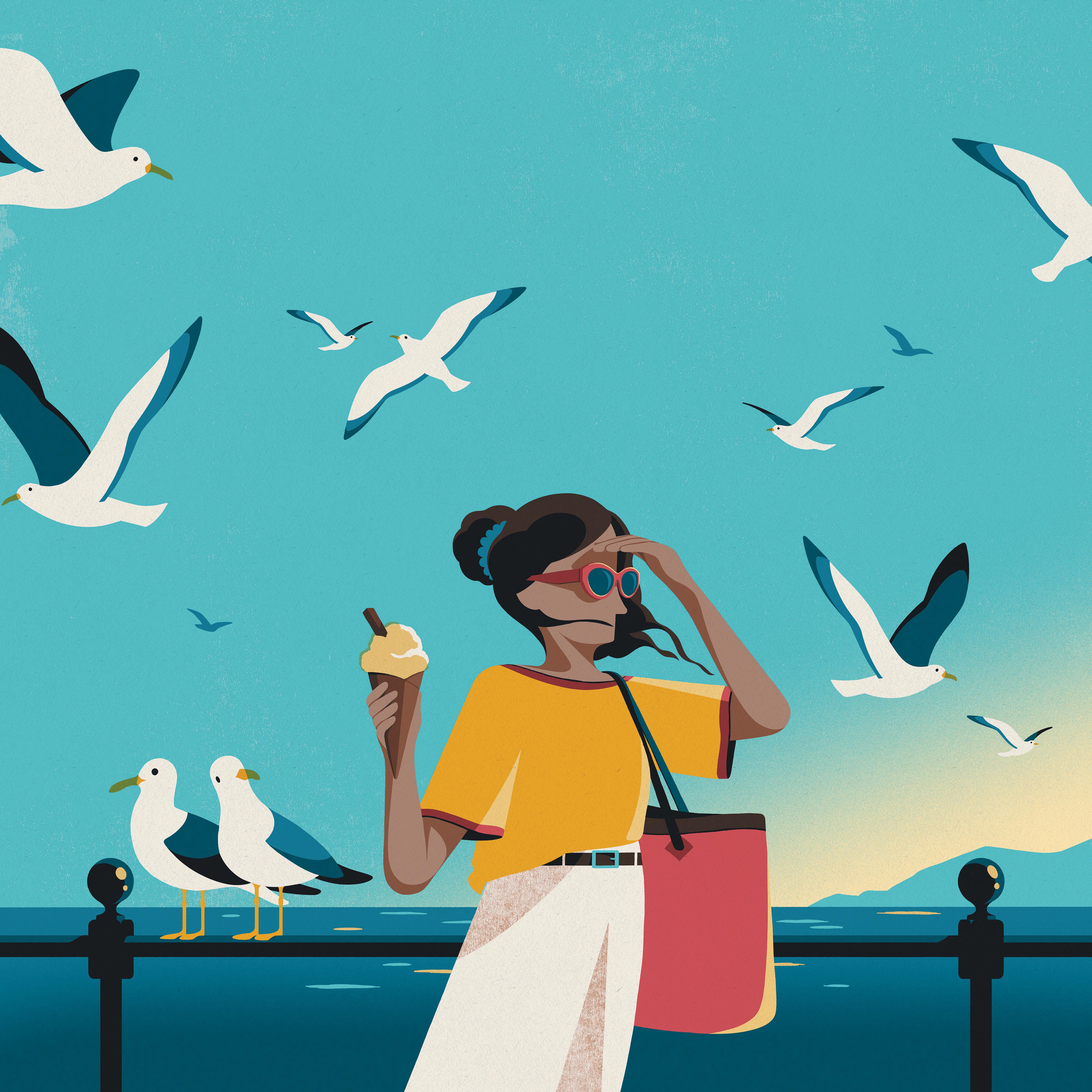

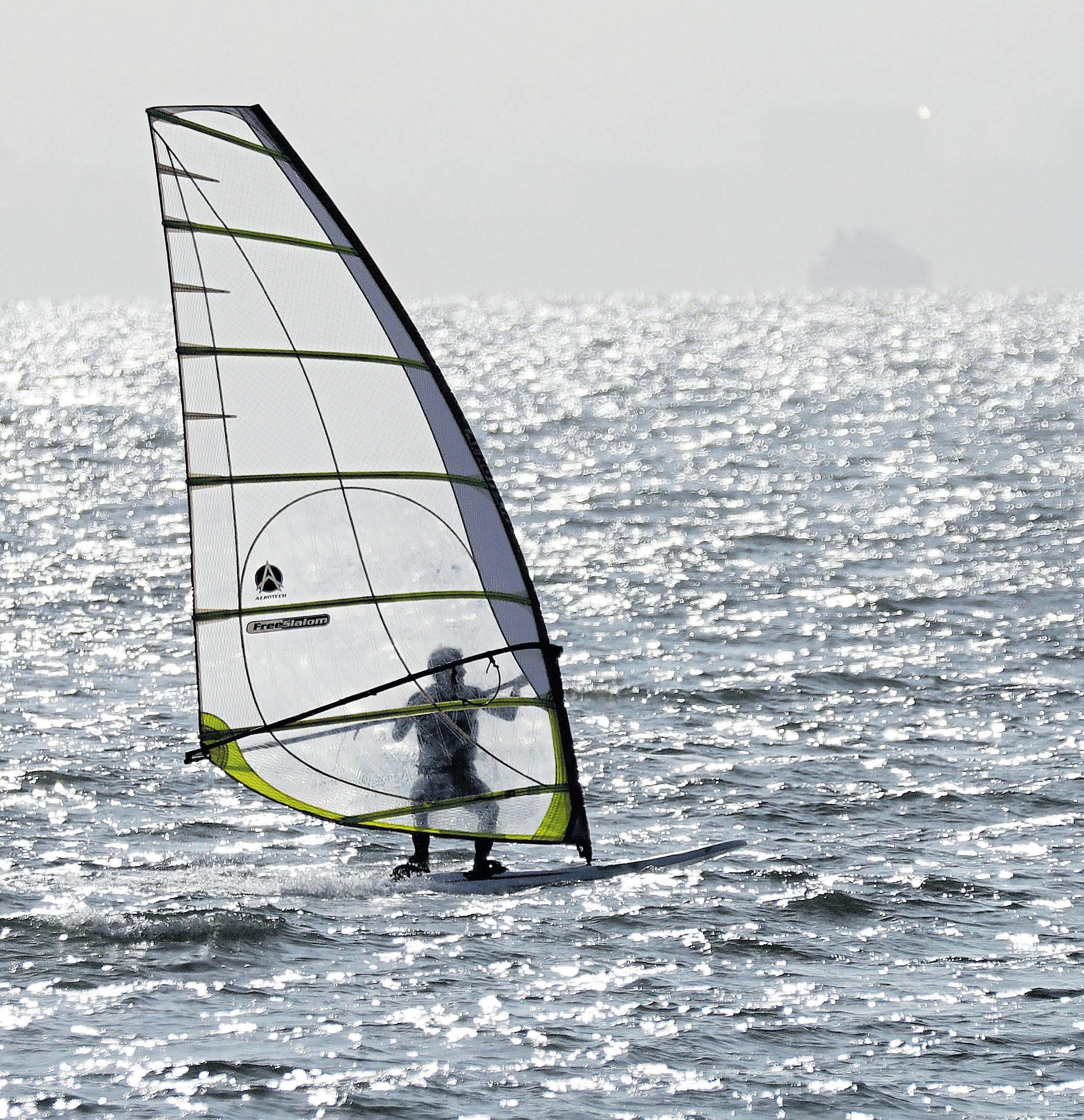

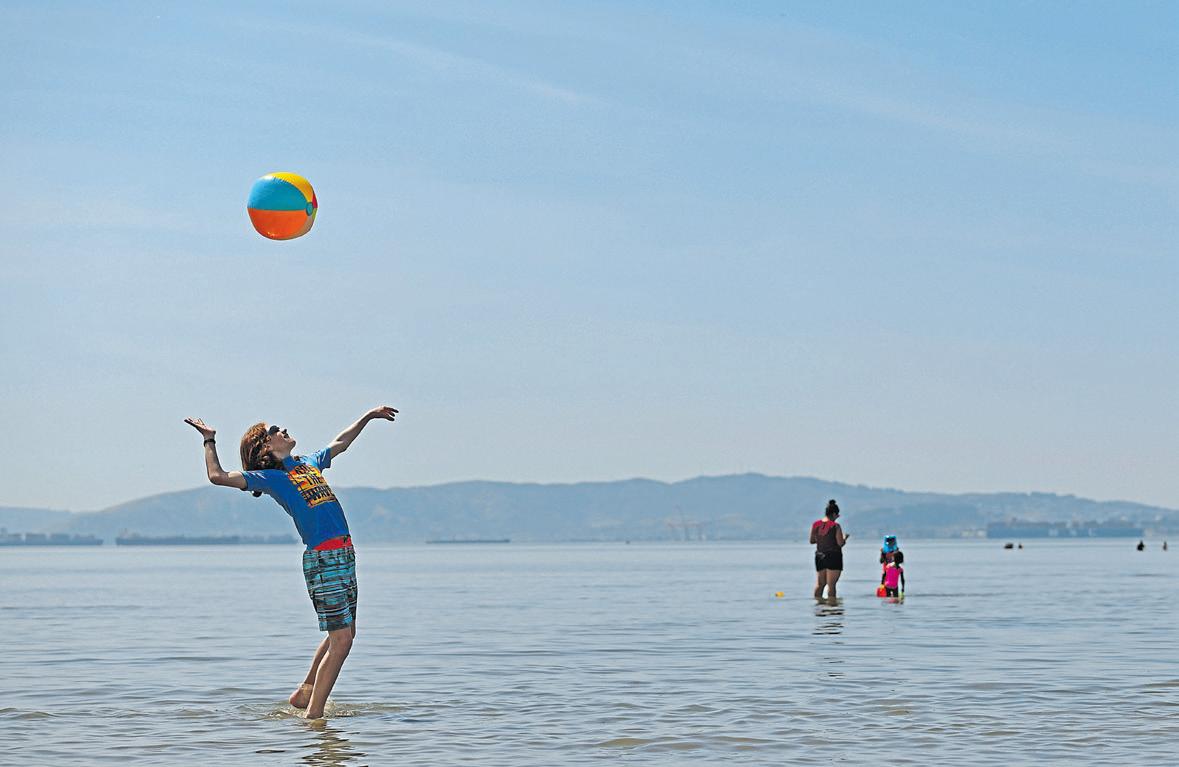
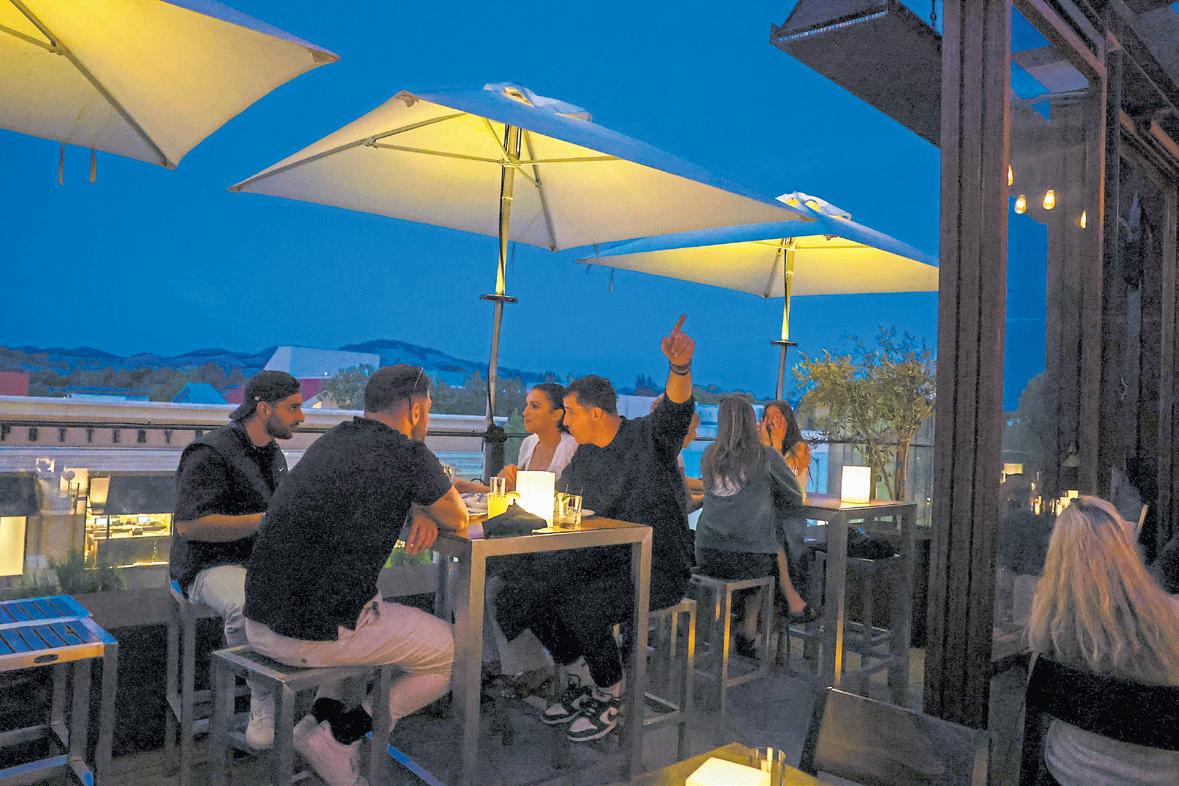
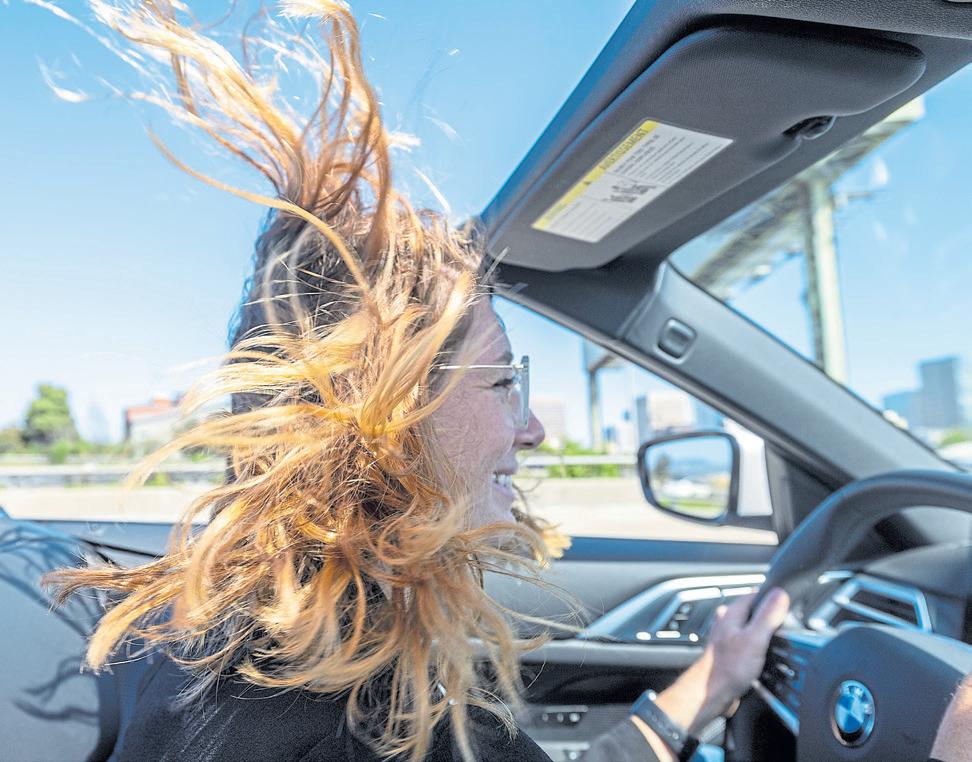
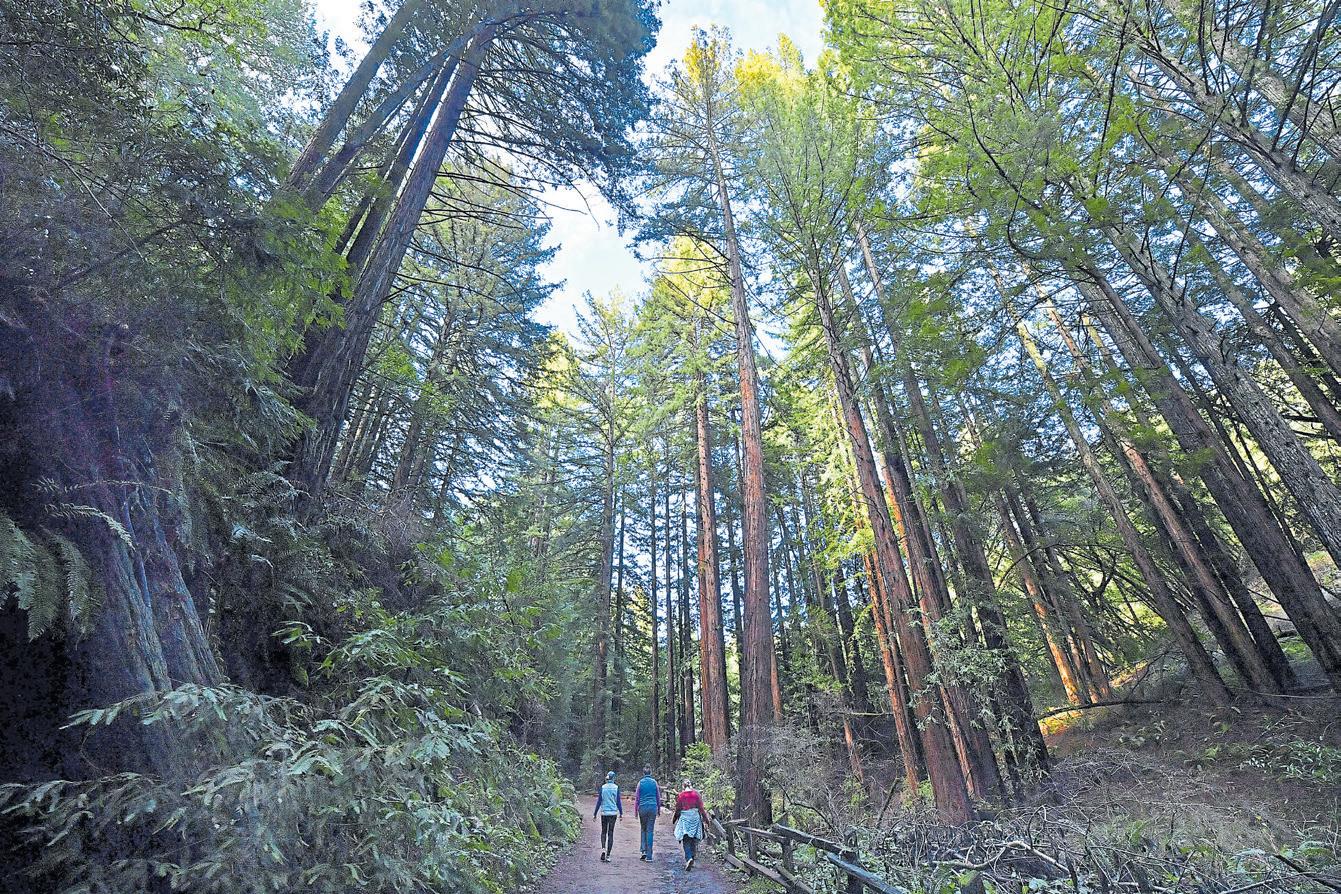
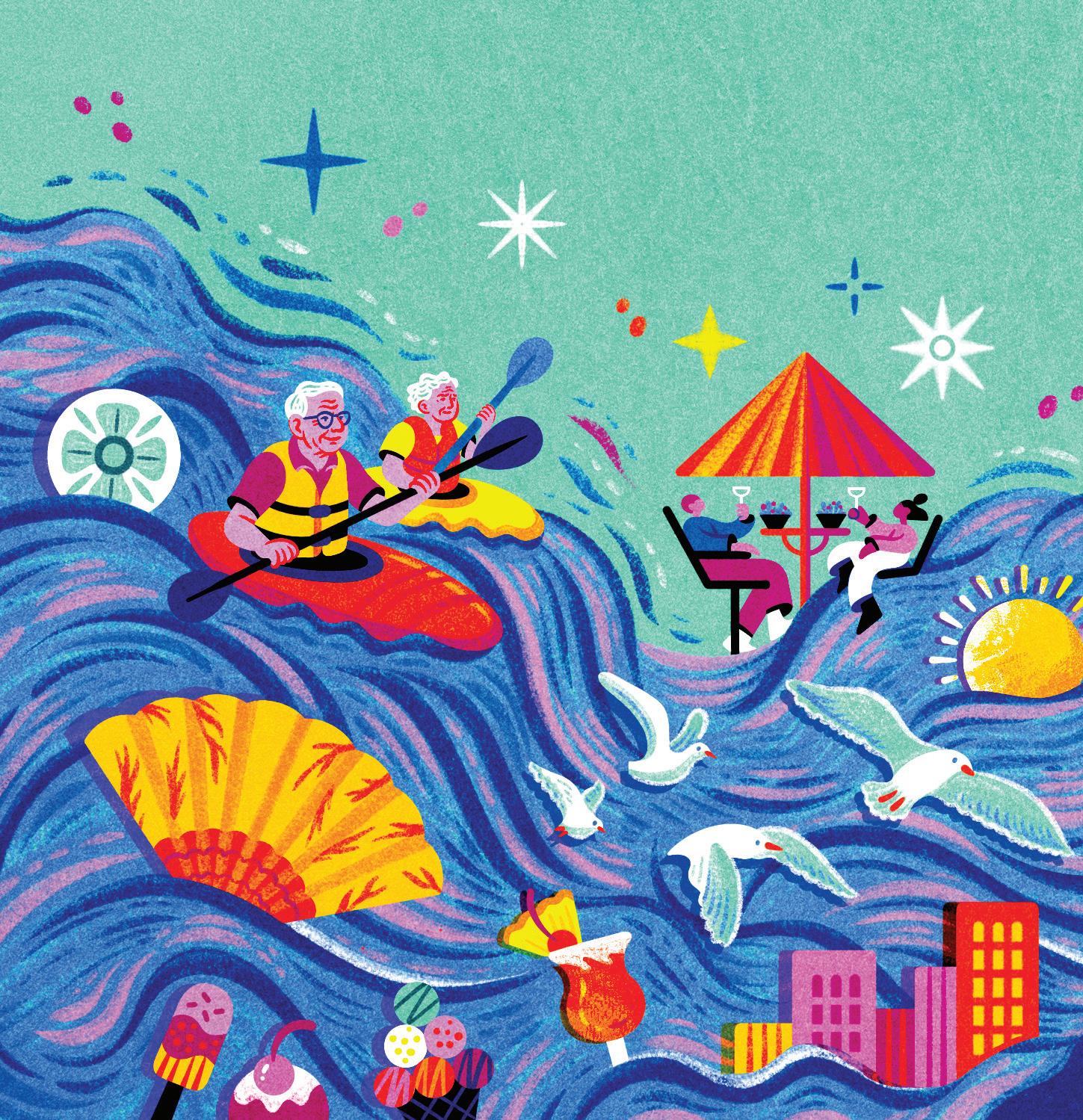












STORY BY LUIS MELECIO-ZAMBRANO
ILLUSTRATION BY CHANELLE NIBBLELINK
The dog days of summer are coming. Cue the strained rattling of AC units, long hours of burning sun and triple digit temperatures that make a sweaty mess of us all.
The Bay Area summer can bring with it some sweltering days, with highs peaking in the 90s and beyond until September. Luckily, the unique geography of the Bay Area means finding relief is a breeze — literally. And blending science with a bit of anecdotal evidence can point the way to several spots that offer the best chance at catching a cool breeze.
The mix of chilly waters and hot inland spots leads to afternoon sea breezes that help keep the region cool. On sweltering summer days, places near the Pacific coast stay relatively fresh, aided by the consistently cool waters of the nearby Pacific Ocean — where temperatures regularly hover around the 50s near the Bay. The inland regions of California, however, don’t have that benefit, and as summer days go on, can bake in the sun.
“That is the big driver in why we have such vast disparities in temperature throughout the Bay Area … It’s not unusual to see a 40 degree temperature range in 40 miles,” said Jan Null, a meteorologist and adjunct professor at San Jose State University. “The farther away you are from the coast, the more it heats up.”
By the afternoon, the air is hotter and less dense, making it rise and leading to areas of low pressure over hot inland regions. This pulls in the cooler, denser air towards the hotter inland regions, generating a cooling sea breeze on most summer afternoons.


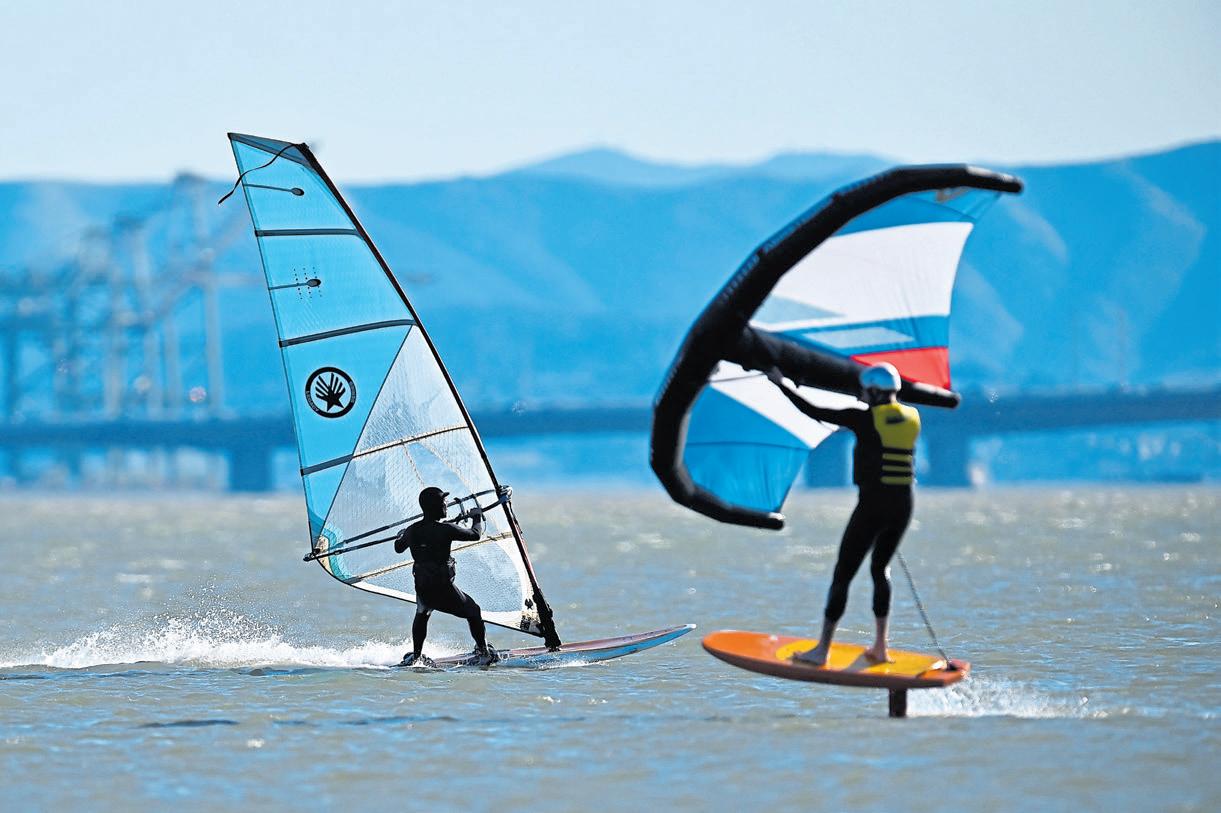
Above: A windsurfer passes a wing surfer as they take advantage of the high winds near the Berkeley Marina in Berkeley.
JOSE CARLOS FAJARDO/STAFF
This wind does double duty in cooling us down. First, it introduces cooler air, not only replacing the hot air regionally, but also refreshing the air that heats up near our bodies as we try to cool off. As that fresh air rushes by our skin, it wicks away sweat, which cools us off further as it evaporates off of our skin.
The mountains of the Bay Area help channel these air currents to specific spots that get more consistent breeze, such as past the Golden Gate Bridge and beyond the break in the mountains near San Bruno. If winds blow through a gap, they can accelerate, said Lamonte Bain, meteorologist with the National Weather Service in the Bay Area. But he warns winds have to “be at a specific direction,” adding “gaps are tricky.”
Making things more complicated is the fact that elevation
and even buildings and tree cover can lead to differences in where the winds blow and the coolest temperatures might be. Bain argues that without a network of weather sensors “on every block,” tracking the complex microclimates of the Bay Area isn’t possible and is often left to anecdotal evidence.
Despite the chancy nature of the weather and the well-meaning hedging of meteorologists, there are some basic guidelines for finding the best spots to enjoy a cooling breeze. For best results, stay close to the coast. National Weather Service meteorologist Dalton Behringer says that especially during heat waves, the benefits of a stiff sea breeze often die down further inland. Those more investigative types can take a look at the direction of the wind and the gaps in topography to guess

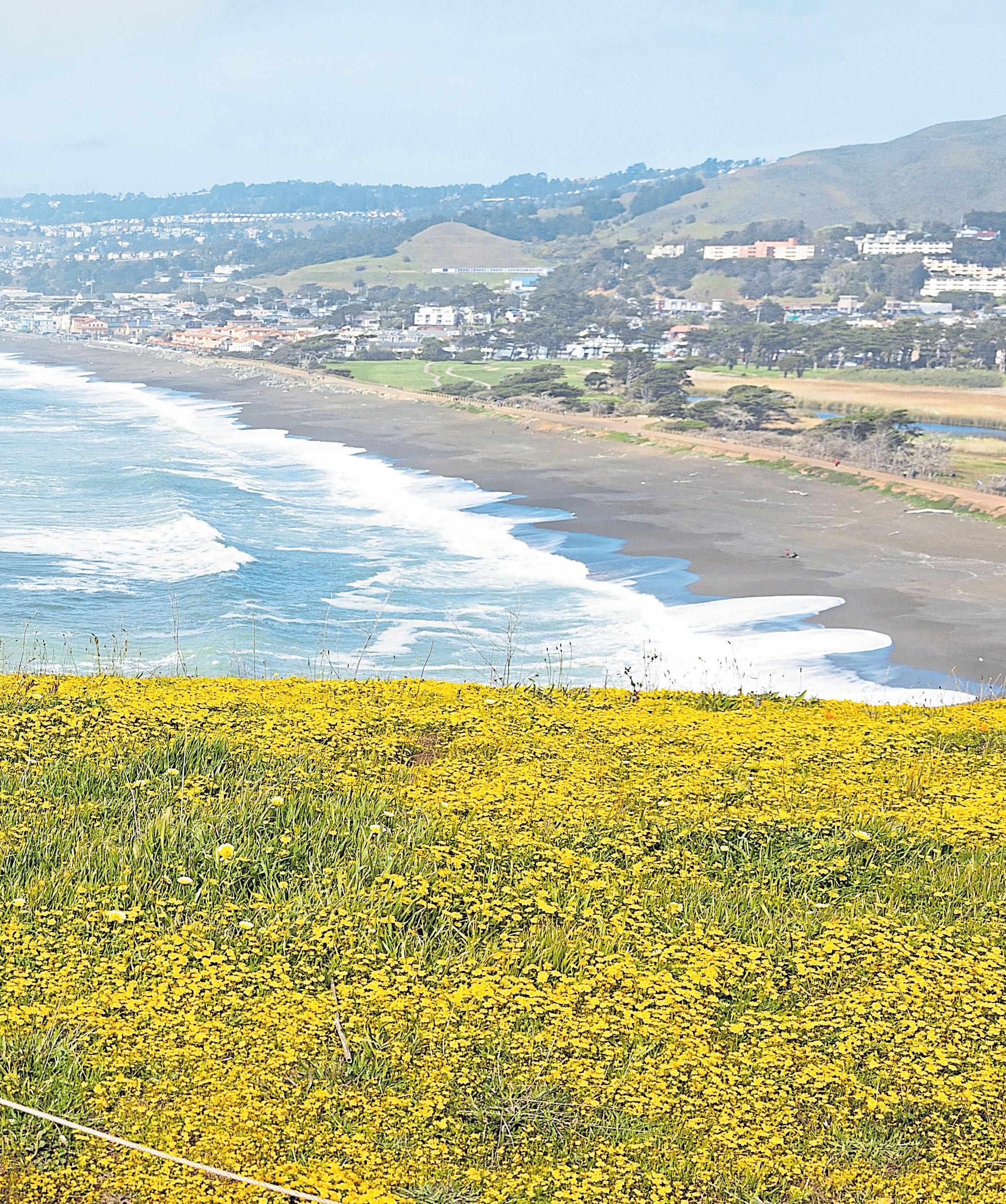
some windswept locales. If that sounds complicated, fear not: we’ve done some of that work for you. Using the guidelines of meteorologists along with interviews of park rangers, locals and wind surfers, we’ve worked to balance scientific explanations with on-the-ground knowledge and give you several suggestions for where to start looking for the coolest breeze.
The beaches on the Peninsula are exposed to the cool waters of the Pacific, making them prime escapes for sweaty citizens seeking relief. The winds flowing over the Pacific coast pull up cold water from the depths to bring a conveyor of often icy ocean waters to shores near the Bay, according to John Largier, professor of coastal oceanography at UC Davis. Additionally, Behringer says that, because of the direction of the winds coming off of the ocean, any beaches north of Half Moon Bay often enjoy lower temperatures. Among these is Pacifica State Beach, which offers surf lessons, some hikes and trails or simply a cool place to take in the views and enjoy the wind tousling your hair and ruffling the pages of your latest beach read. For less refined pleasures, the nearby Taco Bell Cantina is a local favorite, where your Crunchwrap Supreme can come with a boozy frozen drink. Parking for the beach costs $7 for fewer than four hours or $9 for a day.
Elsewhere on the Peninsula, a break in the Santa Cruz Mountains forms the San Bruno Gap, which reaches from the Pacific Coast southeast towards the South Bay. Since winds off the
The winds blowing off the Pacific cool the bluffs at Mori Point in Pacifica.
KARL MONDON/STAFF ARCHIVES

Surfers contemplate the waves at a windy Ocean Beach in San Francisco.
Pacific often blow southeast and the adjacent mountains block the wind, “the air is forced to squeeze through a smaller space, similar to a wind tunnel,” said Behringer. Interestingly enough, that’s also why it’s home to San Francisco International Airport, since planes can take advantage of the wind to help them take off. For those interested in staying closer to home, however, looking down the San Bruno Gap can offer somewhere to escape the heat.
Located just southeast of SFO, Coyote Point Recreation Area stands on a small peninsula that elbows its way into the Bay. Winds funneling south out of the San Bruno Gap make this a favorite spot for windsurfers, but those families with a less extreme taste can find a lot to enjoy. The park hosts a CuriOdyssey, a museum and zoo that houses more than 70 animals and a science playground. Those
coast stays cool because it is close to the cold waters of the Pacific Ocean, while the air further inland heats up.
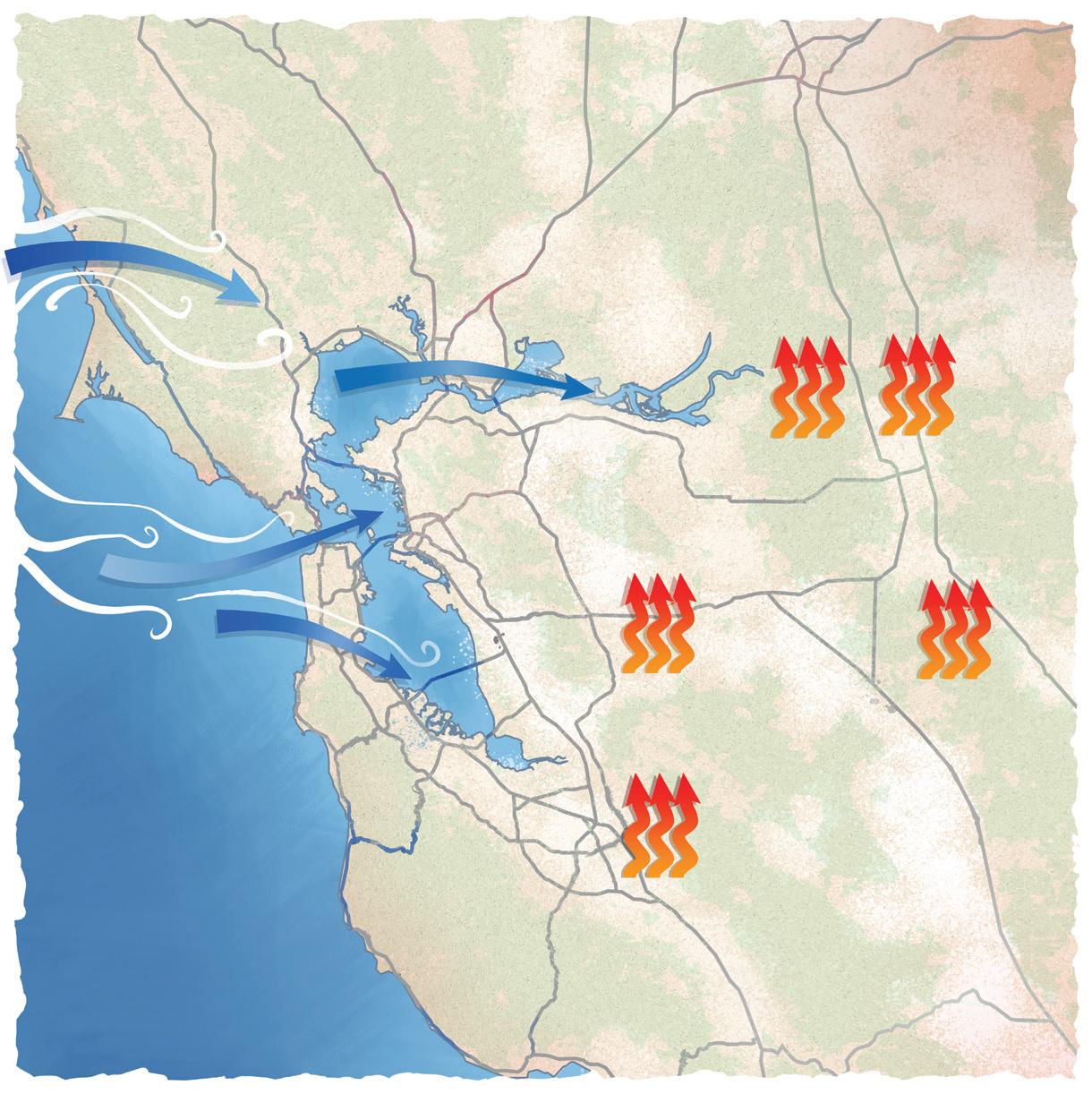

As
who don’t want to shell out an extra $24-$28 a pop for tickets can enjoy a large, dragon-themed playground for the kids, a beach promenade or plenty of space for barbeque and picnics. The cost for entry is $6 per vehicle.
The largest gap in the Bay Area is along the Golden Gate Bridge, between the top of the Peninsula and the North Bay. Since it’s the only gap at sea level, it sees some of “the strongest flow” of air, said Null, and can funnel wind eastward toward the East Bay and even further inland toward Sacramento, creating what is known as the Delta Breeze. Those in the East Bay can take advantage of the path of the breeze to find cool spots along the way. To start off, Behringer notes that Berkeley often benefits most from these winds, saying
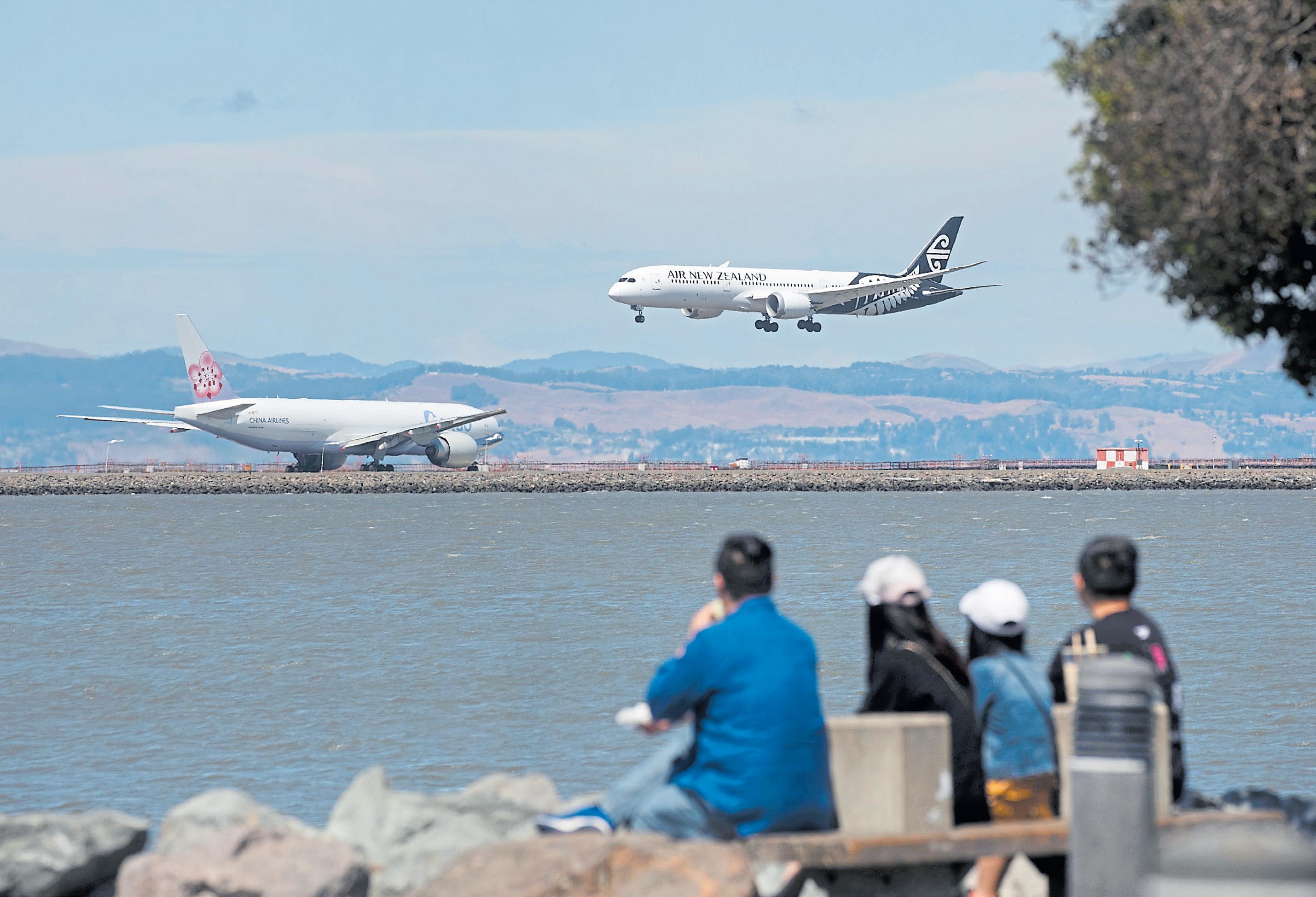
“pretty much the air conditioning is turned on because the winds and moisture are directed at Berkeley.” That makes it no surprise then, that the Berkeley Marina was the longtime host of the erstwhile Berkeley Kite Festival, which once drew tens of thousands to fly their kites on summer breezes. Even now though, East Bay residents can enjoy kite flying, sailing lessons, kayaking and picnicking along the Marina.
Further north, Miller/Knox Regional Shoreline grants panoramic views of the San Fran-
cisco skyline and the shores of the North Bay for those wishing to escape the heat and the city.
“You kind of feel like you’re getting in a new oasis,” said Dave Mason, spokesperson for East Bay Regional Park District. Along with the views, the park offers a small swim beach, 307 acres of land that stretches into hills for hikers and a pier for fishing.
To the south, Alameda Crown Beach offers a 2.5 mile stretch of shore enjoyed by swimmers and frequented by kite surfers. Even so, it’s especially popular on hot days, so Mason recommends
Bayfront Park in Burlingame is a great spot to see the action at San Francisco International Airport, which was purposefully built in a wind tunnel that gives planes a natural boost.
KARL MONDON/ STAFF ARCHIVES
going early to find parking and a spot on the shore. Parking is $5 per vehicle.
For hikers and history buffs willing to take the trek to the middle of the Bay, Angel Island State Park lays out a mecca of windy trails. Because of its position in the Bay, most of the island is actually windward, with only the northeast end being truly leeward, says Angel Island Park interpreter Casey Dexter-Lee, while watching palms sway gently in the breeze. The island offers 13 miles of trails and roads for hiking, bik-
ing trails, which can link to form loops around the island that offer moderate, hilly hikes with scenic views of the Bay. If you left your hiking boots at home, the island also hosts a plethora of historic sites, including an immigration museum, and has options for bike rentals, ebike rentals and tram tours. Admission to the park is included in ferry tickets ($15.50 one way, or $9.50 with a Clipper Card, from Pier One and $18 round trip from Tiburon), though the immigration station costs another $5 for adult admission.
The dining is divine at five open-air spots with all-around views
BY LINDA ZAVORAL, MARTHA ROSS AND JOHN METCALFE
The Bay Area has embraced sky-high hospitality. Rooftop restaurants and bars are attracting diners for fresh-air views paired with shareable small plates at sunset, brunch on sunny weekends and drinks late into the cool evenings. Here are five to put on your must-visit list:
PRESIDENT’S TERRACE
Palo Alto
For a 360-degree Peninsula panorama — plus bites, drinks and a dose of history — head to the top of the Graduate by Hilton Palo Alto.
Enter through the ornate, art-filled lobby of what was once the Hotel President. Named after Herbert Hoover, who attended Stanford University, the President opened in 1929 and operated as a hotel for 40 years, then as apartments for 50-plus
President’s Terrace in Palo Alto offers a panoramic view of the Peninsula.
SHAE HAMMOND/ STAFF
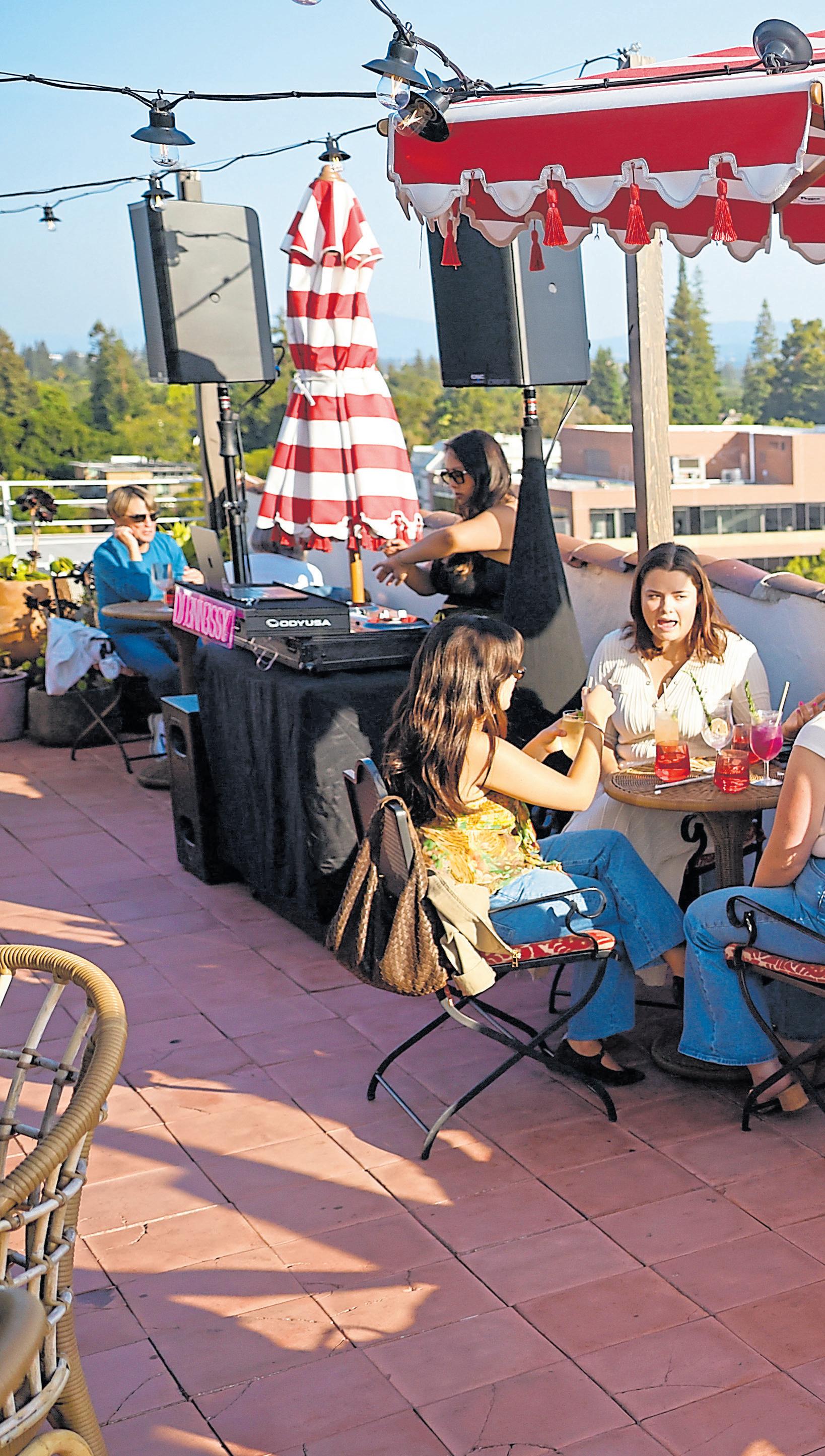
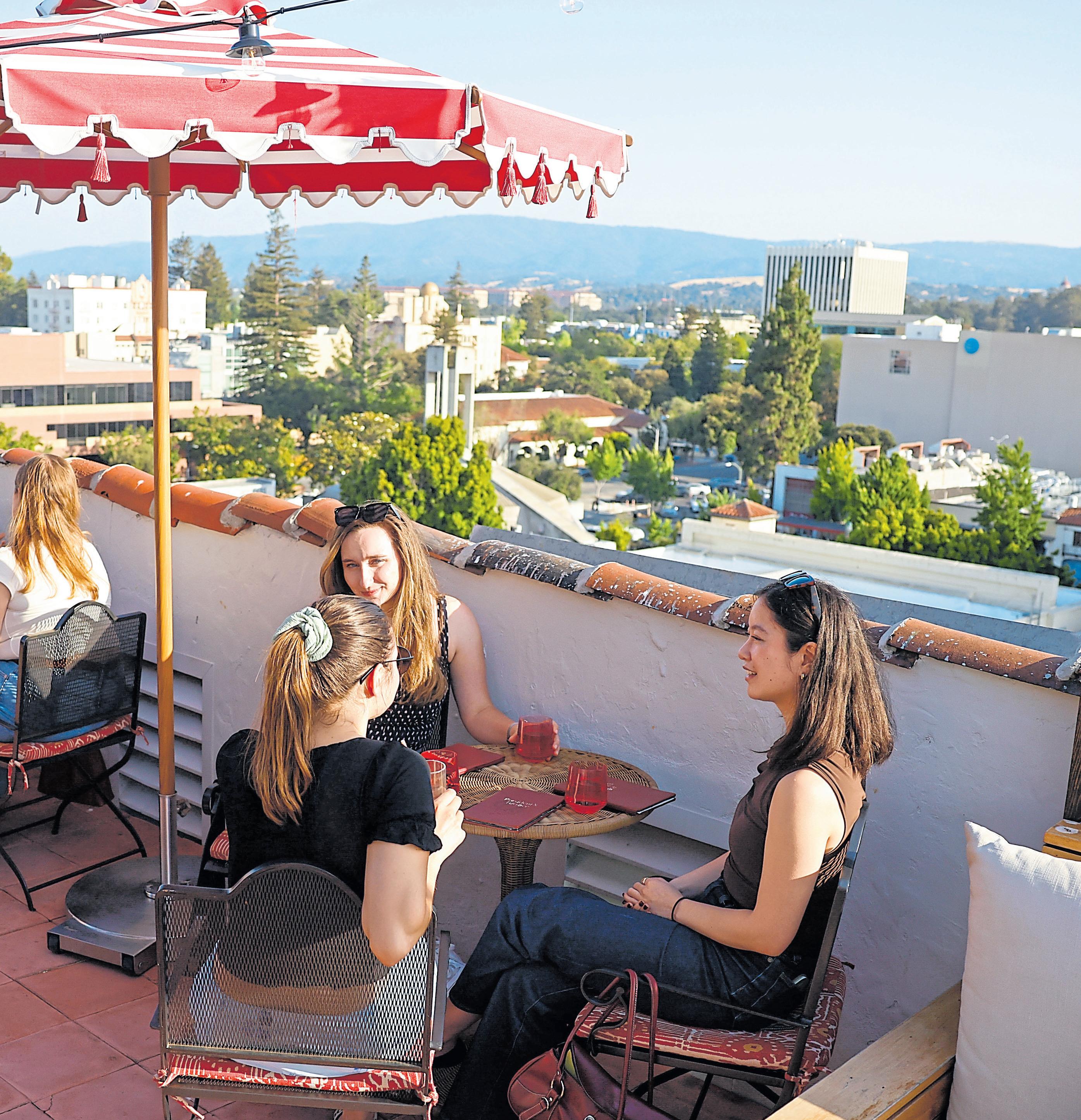
years until its conversion back into a hotel.
Since the reopening, the lovely rooftop terrace atop the Spanish Colonial Revival building, designed by noted architect Birge Clark, has been a big draw. On any given night, the clientele is likely to include longtime locals enjoying a light dinner and the views, tech bros talking too much to take in the views and Stanford students sipping the nonalcoholic specialty, “Lou’s Brew,” a fruity, fizzy tea drink ($15) from the “School Nights” menu.
Those 21 and over have an impressive array of wines from which to choose as well as a Stanford-themed cocktail list.
Try the gin-based “Crimson Cooler” ($20) or start a conversation around the table with the “Banned from Disneyland” rum concoction ($19), a cheeky nod to the marching band’s antics.
Seafood choices dominate the small plates, including the particularly popular West Coast Oysters ($25 for six) and Warm Crab Dip ($24). On the Land side of the menu, Meatball Sliders ($22 for three) and Artisanal Cheese & Charcuterie ($30) are the most often ordered.
When the evening gets chilly, overhead heaters click on. If you need more warmth, grab a blanket from the basket near the elevator. The walls in the alcove are worth your attention, too, as they are papered in vintage postcards, menus and other Palo Alto ephemera. Makes for some nice, nostalgic “Who remembers
Rooftop Restaurant and Bar in Walnut Creek features a retractable roof and sliding glass walls on both sides.
RAY CHAVEZ/STAFF


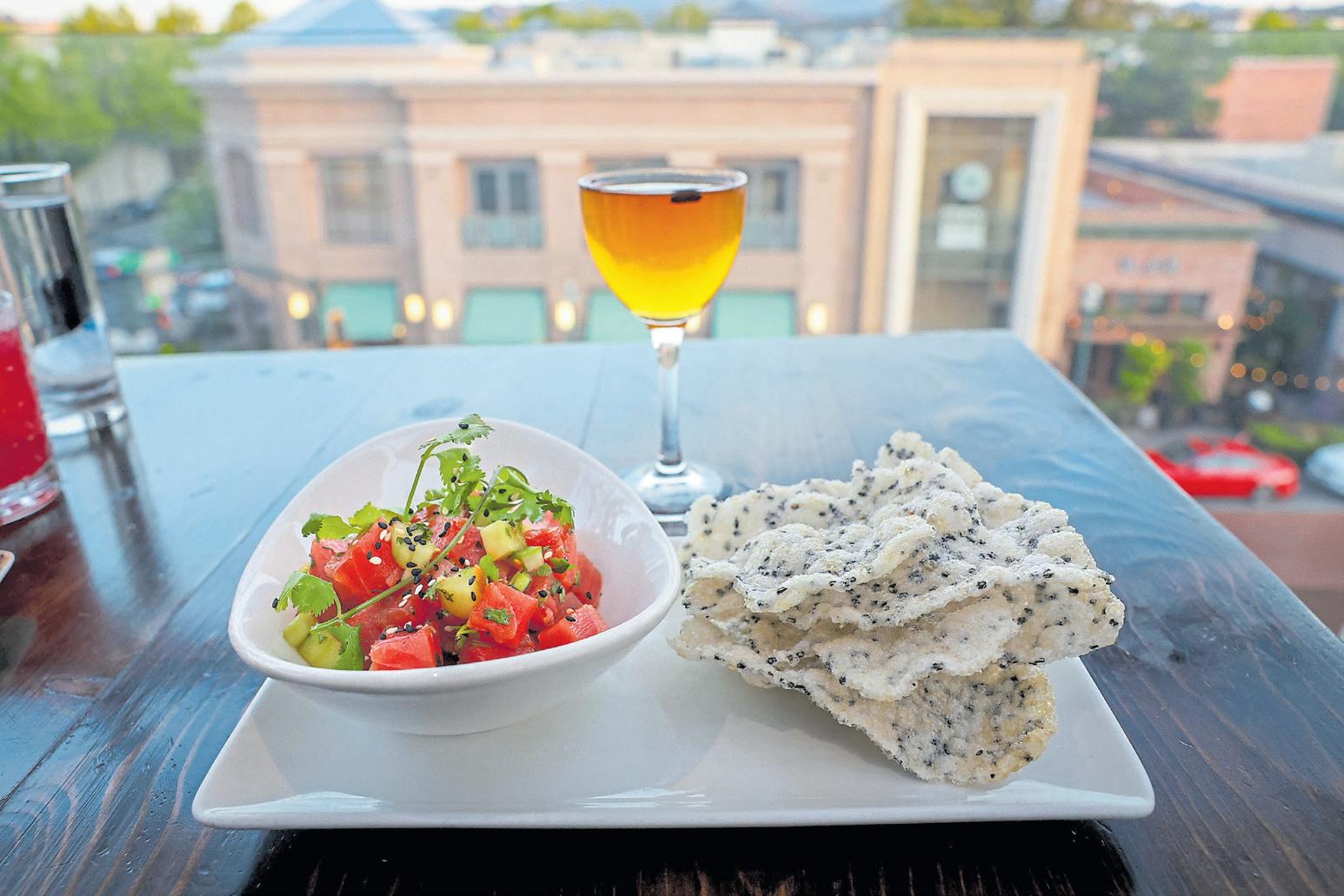
to
Details: Open daily from 4 p.m. until 10 p.m. on Sunday-Thursday, 11 p.m. on Friday and Saturday. 488 University Ave., Palo Alto; www.graduatehotels.com/ palo-alto.
ROOFTOP RESTAURANT AND BAR
Walnut Creek
This trendy third-floor restaurant in the heart of Walnut Creek’s bustling downtown was definitely built to fulfill its function as a rooftop restaurant.
Located at the top of an oldtime, warehouse-style, brick and steel building, Rooftop has two balconies overlooking the city’s premier intersection. And, on a summer evening, a retractable roof and sliding glass walls on both sides can open up pretty much the entire bar and restaurant to the sky, soft breezes and
Tuna tartare with toasted rice cracker and a Café Oro drink are on the menu at Rooftop Restaurant and Bar.
views of Mount Diablo.
Rooftop, the latest in a line of Walnut Creek hotspots operated by longtime restaurateur Jeff Dudum, is both casual and classy, a setting for a date night, a girls’ night out or a special-occasion family gathering. There’s a three-sided bar with large TV screens for watching sports, but the rest of the dining room avoids a sports-bar vibe, with low-key techno pop or live music in the background.
Diners can start their meals with a handcrafted cocktail, a sparkling wine or a Russian River Valley Pinot Noir to accompany a plate of Hog Island oysters ($22-$39) or a ginger-spiced tuna tartare ($24). Chef Hugo Arias brings flair to Rooftop’s take on American and Asian classics, such as steamed pork dumplings with tamari broth ($20), a wedge salad with chunks of bacon and blue cheese ($16) and the crispy duck breast with grilled peach salad ($39). Rooftop recently began offer-

ing a special late-night menu for Friday and Saturday, featuring its popular Rooftop Burger ($23) and Dungeness Crab Cakes ($29), ideal for those hungry after a movie at the nearby Cinemark Theatre or a concert at the Lesher Center for the Arts.
Details: Open 11:30 a.m.- 9 p.m, Sunday-Thursday, with the bar closing at 10 p.m.; 11:30 a.m.-10:30 p.m., FridaySaturday, with the late-night menu starting at 10:30 p.m. and the bar closing at 12:30 a.m. 1500 Mt. Diablo Blvd., Walnut Creek, www.rooftopwc.com/.
San Jose
It’s a beautiful evening. Are you feeling lucky? Head up to the Copita rooftop, overlooking Willow Glen’s restaurant row, to see if you can score a table or one of the four coveted lounge areas with a fire pit. The view extends from the lights of Lincoln Avenue below to the Santa Cruz Mountains in the distance. This contemporary Mexican restaurant is colorfully designed and tiled — with creative food
Bartenders prepare ingredients at Copita in San Jose’s Willow Glen neighborhood.
KARL MONDON/ STAFF ARCHIVES
to match. Bay Area celebrity chef and owner Joanne Weir and business partner Michael Mindel brought in Azari Cuenca-Maitret, a culinary star from Mexico City, as executive chef.
The rooftop offers a condensed menu — if you consider 25 items condensed. Order Chips & Salsas ($5), one guajillo and one tomatillo, while you sip a cocktail and peruse the menu. Consider sharing a seafood starter — the seared yellowfin Tuna Tostadas ($17) or the Coconut Campechano ($20), with shrimp, scallops and flounder. Next, a main course. Seeing as how Chef Azari was once Mexico’s ambassador to the pork industry, you can’t go wrong with the 24-Hour Carnitas ($26) or the Trompo trio of tacos ($20) with marinated, spit-roasted pork and caramelized pineapple.
Copita backs up its “tequileria” name with dozens of tequila and mezcal options and also boasts not one but two full bars, one on this rooftop and one in the main dining room. Among this summer’s new cocktails is La Passione, a zesty, fruity margarita created by the bar team’s Adam Wilson and Janees

Martinez that combines Catedral mezcal, mango and housemade cinnamon syrup.
Details: Copita’s rooftop is open Wednesday-Sunday, weather permitting. Seating is first come, first served. 1098 Lincoln Ave., San Jose. Main restaurant reservations: www.copitarestaurant. com/willow-glen-home/
Berkeley
Perched on one of the tallest buildings in Berkeley, a Marriott Residence Inn, the Study Hall Rooftop Lounge is not actually conducive to studying. The vibe is low-key “party” with DJs and live music on weekends and

island drinks the color of radioactive bubblegum. A commanding 360-degree view of the Bay tends to distract one’s focus.
Still, a dedicated student could probably pull it off by nestling into the comfy, heat lamp-warmed lounge furniture that dots the open-air terrace. Some brain food might help. The kitchen does Oceania-influ-
enced cuisine, and the double-patty Wagyu cheeseburger with garlic aioli is a hearty meal ($24, add fries for $7), while soy-glazed Brussel sprouts with Fresno chile ($15) provide your nutrients.
Study Hall sits at UC Berkeley’s front door and attracts a hearty student contingent plus their families staying at
the hotel below. It’s become a regular drop-in spot before and after college games. Cocktails reflect school pride, like the Berkeley Bash with Sonoma rye and Fernet and Campus Bird with reserve rum, pineapple and mole bitters ($18). Regular folks can join in the fun, too, by ordering a beer or glass of wine and watching ESPN at the bar.
Details: Open 4:30 p.m.-10 p.m. Sunday-Thursday and 4:30 p.m.midnight Friday-Saturday at 2121 Center St., Berkeley; www. studyhallrooftoplounge.com.
San Jose
It takes a commitment to gaze at the sunset from Santana Row’s highest bar. First, you need to check the website to see if this alfresco lounge has been booked for the night by a private party. If all systems are go, then head to the Row and commence the search for parking. Once you are at the hotel, the doorman will guide you to the nearby elevator, the first of two you’ll take to get to the seventh floor.
You’ll be rewarded for the effort with widely spaced tables and lounge areas and a nottoo-loud soundtrack, making conversation easy. The clientele represents a broad mix: BFFs catching up, tech and marketing folks taking a break from their latest projects, couples getting a drink before dinner. Snag a spot, maybe near one of the bougainvillea-adorned walls, then head to the bar to order food and drinks.
California varietals dominate the wine list (glasses from $19 up to $35 for a Silver Oak cab). The array of cocktails includes Lychee and Espresso Martinis ($20) plus mocktails like the Hibiscus Sparkling Lemonade.
Diners enjoy the view at the Study Hall Rooftop Lounge in Berkeley.
WANGYUXUAN XU/ STAFF
Nibble on Ahi Tuna Tacos ($16) or Spicy Chicken Croquettes ($12) or go Iberian with the Spanish Charcuterie ($24), lined with three Spanish cured meats, three cheeses, cubes of quince paste, grapes and crackers. That tray can be dinner for two or snacks for four.
Details: Open from 5:30 to 9:30 p.m. Tuesday-Sunday at the Hotel Valencia, 355 Santana Row, San Jose. Events calendar: www.hotelvalenciasantanarow.com/events-calendar.aspx
icy, exotic treats to help you beat the summer heat
BY KATE BRADSHAW
The sun is hot, and it’s time to cool down. Fortunately, a world of refreshing flavors awaits, all right here in the Bay Area. Sample eight of the tastiest frozen fruity treats, from strawberry Korean bingsu to a Mexican mango-lime paleta, Filipino ube halo-halo to pineapple Thai rolled ice cream.
Santa Clara
Feeling nostalgic for the era of the Choco Taco? Rocko’s Ice Cream Tacos, which opened in 2018 as a brick-and-mortar shop in Santa Clara, picks up where Choco Tacos left off (Klondike discontinued the brand in 2022), adding customizable flourishes to its reimagined concept. Start with a waffle cone shaped like a taco shell, stuff it with your ice cream selections, then have it dipped in chocolate, rolled in toppings and flash-frozen in liquid nitrogen.
Try: A custom ice cream taco: almond cherry chocolate ice cream matched with a chocolate coating and rainbow sprinkles.
Details: Open 5:30-10 p.m. TuesdayFriday, 1:30-10 p.m. Saturday and 1:30-9 p.m. Sunday at 2905 Park Ave, Santa Clara; rockosicecreamtacos.com.
Union City and Oakley
Polar Bear Rolled Ice Cream, which started in Oakley in 2018 and expanded to Union City in 2023, uses a technique popularized around 2009 in Thailand, sometimes called stirfried ice cream, to prepare rolled ice cream strips, each served made-to-order on the spot. A liquid mixture is poured onto an ice pan, mix-ins are added, and the cooled strips are scraped into rolls.
Try: The piña colada Thai rolled ice cream ($10 and up), featuring a vanilla base, mixed with pineapple and coconut, and topped with whipped cream and crushed pineapple.
Details: Open 2-9:15 p.m. weekdays and 1-9:15 p.m. weekends at 34608 Alvarado-Niles Road, Union City and 12-9 p.m. daily at 2581 Main St., Oakley; polarbearicecream.net.
PALETA PLANETA
San Jose
Brothers Mauricio and Luis Salazar started their paleta shop out of their parents’ garage in east San Jose in 2021, taking online and Instagram orders, according to Mauricio Salazar. Through a Prosperity Lab grant, they expanded to a ghost kitchen, expanding their busi-

ness selling their fresh paletas at pop-up markets and arts events around the city. Today, they’ve got a brick-and-mortar ice pop shop across the street from San Jose City Hall with a rainbow of flavors. The most popular is cookie monster — an Oreo and Chips Ahoy! blend — Salazar says. But they’ve got more than 250 flavors, and that frequently changes, he adds.
Try: A fruit paleta, topped with savory chamoy and tajin for a sweet, slightly spicy flavor boost.
Details: Open 12-8 p.m. MondayThursday and 12-9 p.m. Friday-Sunday at 150 E. Santa Clara St, San Jose; paletaplaneta.com.
Rocko’s Ice Cream Tacos in Santa Clara is all-in on Choco Taco nostalgia.
Walnut Creek, Burlingame, Palo Alto, San Jose
Palmetto Superfoods, which started in 2019 in San Francisco before expanding throughout the Bay Area, traces its roots to Cafe de Casa, where its owners, Thais and Amanda Moreira, teamed up with Charles Lee and Hessam Shirmohammadi to create the acai-focused brand.
Try: The customized acai bowl ($13 and up). The menu offers some precrafted blends, or you can explore a rainbow of frozen, fruity bites — from acai, coconut and mango to blends like ube blackberry, spirulina and chia pudding, plus a selection of toppings, including peanut butter, granola, fruit, seeds and nuts.
Details: Open 8 a.m.-8 p.m. daily at most locations; palmettosuperfoods.com.

Campbell
This Arizona-based dessert shop, which specializes in an array of Korean desserts, expanded to Campbell in 2023. You’ll find taiyaki buns, soft serve, boba and espresso drinks, but the shop’s snow desserts are particularly elaborate, with flavor combos like “Tira-Miss-You” (serving up strawberry, chocolate and tiramisu bites) and the coffee-flavored “Espress-Snow.”
Try: The snow, also called bingsu. It’s a milk-based shaved ice dessert that changes texture as it melts in one’s mouth. It starts flavorful, yet dry, almost like eating fresh-powdered snow, before it liquefies into creamy, chilly mouthfuls. A strawberry-topped version with mochi bites adds extra freshness and chewiness.


Details: Open 12-9 p.m. Sunday, Monday, Wednesday and Thursday and 12-9:30 p.m. Friday-Saturday at 715 W. Hamilton Ave #1130, Campbell; snowtimedesserts.com.
CAFE 86
Mountain View, Antioch, Union City, San Jose
This cafe’s purple color scheme belies its specialization: all things ube. The purple yam that originated in the Philippines is the star of the show at Cafe 86, where visitors can find ube butter bars, leche flan, bread pudding, boba drinks and more. New locations are in the works in Milpitas, Daly City, San
and soft serve combo has found a loyal following here. And for good reason: Their freshly pressed waffle cones are shaped like little fish, and inside each, visitors get to choose among a variety of colorful, flavor-rich options for the base fillings lining the cones, soft serve flavors and toppings. The result? A highly Instagrammable and delightfully inhalable treat perfect for snacking on a summer stroll.
Try: The taiyaki with soft serve, a Korean dessert known as ah-boong. Though subject to change, the dessert shop has flavors like ube, matcha, chocolate, strawberry and more, plus fillings inside the base of each freshly shaped cone, including Nutella, custard and red bean paste. Toppings include fruity pebbles, coconut flakes and Oreo crumbs, for starters.
Details: Opens daily at noon at most locations; somisomi.com.
Ramon, Concord and Livermore.
Try: The upside-down halo-halo, made with an ube slushie featuring coconut jellies, jack fruit, boba, frosted flakes and vanilla ice cream. The hodgepodge of textures and flavors brings something interesting — and delicious — to every bite.
Details: Open 12-8 p.m. Sunday-Thursday and 12-9 p.m. Friday-Saturday at 738 Villa St., Mountain View; cafe-86.com.
Given that SomiSomi began in Los Angeles’ Koreatown in 2016 and already has eight Bay Area locations, the chain’s taiyaki
Founded by two entrepreneurs from Sunnyvale, Ketki Dandekar and Arshiya Shaikh, Pints of Joy was born after the two women created a pandemic pod with their families. Feeling nostalgic for the Indian dessert flavors of their childhoods, they started experimenting with ice cream. Their creations — with flavors like gulab jamun, fig and walnut, and custard apple — have been a hit; they recently opened a second location in Fremont.
Try: The alphonso mango ice cream. The shop has both dairy-based and dairy-free versions, and it’s an ultra-refreshing way to beat the summer heat.
Details: Open 11 a.m.-10 p.m. TuesdaySunday and 2-10 p.m. Monday at 3768 Capitol Ave., Suite I, Fremont, and 11 a.m.-10 p.m. Tuesday-Thursday, 11 a.m.11 p.m. Friday-Saturday, 11 a.m.-10:30 p.m. Sunday and 2-10 p.m. Monday at 717 E. El Camino Real #6, Sunnyvale; pintsofjoy.com.
Top: Korean bingsu — a milk-based shaved ice that’s chilly and creamy — at Snowtime Cafe in Campbell.
Bottom: A scoop of Falooda ice cream on two scoops of Blueberry Lavender at Pints of Joy in Sunnyvale.

The most unusual cruise ship in the Bay Area was connected to a U.S. president, Elvis and drug smuggling


BY JOHN METCALFE
In the Bay Area, nice ships are a dime a dozen.
But there’s only one ship that was the presidential yacht for Franklin D. Roosevelt and owned by Elvis, then later impounded in one of the biggest drug busts in U.S. history, before sinking in 30 feet of water — and then improbably rising again as a National Historic Landmark.
It’s the USS Potomac, and it’s open for public tours in Oakland’s Jack London Square. Even locally, however, most people haven’t heard its story.
“She’s a relative secret, still,” says John Eichel, a volunteer docent for the nonprofit USS Potomac Association. “Many folks in Alameda, right across the water, don’t even know about it.”
On this particular day, Eichel is giving a tour to a small group who board the ship as the breeze kicks up and the temperature — hot and dry on land — drops several degrees. Pelicans soar drunkenly, and cormorants slip snakelike below the brackish estuary. There’s an inquisitive sea lion that sometimes visits, too, but he seems to be taking the day off.
Ivory-white and 165-feet long, the modified U.S. Coast Guard cutter casts a presidential aura despite a weld transecting its midriff like a nasty surgical scar, evidence of post-sinking renovations. In the 1940s and ’50s, she chugged around the Eastern seaboard and earned the nickname the “Floating White House.” Roosevelt did indeed use her

for official purposes, like entertaining foreign heads of state, such as King George VI and Queen Elizabeth, and conducting secret wartime meetings.
Partially disabled from polio (or perhaps Guillain–Barré syndrome, according to modern theories), the president had a smokestack converted into a hand-powered, rope-and-pulley elevator and a settee where he could put his feet up to enjoy his famously weird martinis. The front end of the boat is where Roosevelt conducted business, and the back was the presidential or “party end,” says Eichel. “So it’s business in the front, party in the back,” quips a visitor.
The top speed used to be 20 knots, but now it scoots around at 11 knots. “Unless we have Captain Richard. He likes to push things a bit,” jokes Eichel. The same visitor pipes up again: “Sounds like he belongs on the party side of the boat.”
The Potomac offers tours between one and three hours long as well
President Franklin D. Roosevelt used the Potomac for entertaining heads of state, such as King George VI and Queen Elizabeth, shown here in 1939.
as dockside tours for landlubbers, which is what we’re doing today. It’s hired out for charters, does special cruises on military dates like Veterans Day and VJ Day and hosts wine tastings and music by blues and cover bands.
In November, the ship will host what Jennifer Pettley, executive director of the USS Potomac Association, calls an “Elvis concert live on board.”
“We have an Elvis impersonator, one of the best in the Bay Area,” she says.
Right now, though, Eichel is pointing at a toilet. There were more than 50 crew members when FDR was in charge, including U.S. Navy and Secret Service personnel, and most had to share a single “head.” There were other inconveniences if you weren’t white. The sleeping bunks for Filipino crew members were located in the ship’s front, where waves hit hardest, one of the more outward signs of discrimina-


“She’s a relative secret, still. Many folks in Alameda, right across the water, don’t even know about it.”
John Eichel, a volunteer docent, speaking of the USS Potomac.
a volunteer docent.
Some say Roosevelt used the Potomac to get away from the pressures of office. Others say it was to get away from Henrietta Nesbitt, the housekeeper who supervised the kitchen at the White House. Nesbitt’s motto was “plain foods, plainly prepared,” and the cuisine was so repetitive guests knew what they’d eat by what day it was: Monday was tongue with broccoli, Tuesday boiled beef with mixed greens.
DAI SUGANO/STAFF
tion at the time.
Roosevelt hated flying and was a lifelong boat guy. He sailed the Hudson as a kid and went on to become assistant secretary of the Navy. He preferred his ships constructed of metal, like the Potomac, because he didn’t want to be trapped on a wooden one in a wheelchair while it was burning, according to Eichel.
“I think he found his greatest moments of relaxation and peace when he was on this boat or another boat,” says Tom Dana,
“And so it happened that the most powerful man in the free world often spent his dinners eating only what he could bear,” reads a sign onboard the ship, “then rummaging up egg sandwiches in a little kitchen next to the presidential study.”
Roosevelt used the party end of the ship for his “Children’s Hour,” named after a Henry Wadsworth Longfellow poem, which was a time of hobnobbing with his inner circle and guests, where talk of politics and business was forbidden. With a Naval aid holding his arm, he’d hold court while mixing cocktails whose recipes were seemingly beamed down from Mars.
“The martinis started out simple enough, usually as a 3:1 or sometimes 4:1 gin and dry vermouth,” according to a 2021 article from a National
Archives technician. “Shaken over ice. Cocktail glass. Olive or lemon peel garnish. Then it gets complicated.... Perhaps he might add some fruit juices or liqueurs or substitute with an alternative liquor for gin when his home bar was limited. Sometimes an extra measure of gin to be on the safe side, as he could lose track of his measurements while deep in storytelling. You can see how quickly things could get out of control. According to his grandson Curtis, the martinis were said to be ‘truly awful.’”
The Potomac made endeavors as mundane as fishing trips in the Gulf of Mexico — FDR loved fishing and once sent an “extremely ugly” catch for inclusion in the Smithsonian — and as secretive as a clandestine meeting with Winston Churchill for World War II’s Atlantic Charter conference. But as the war ramped up and German U-boats patrolled the coast, she was confined to local waters and eventually sold to the state of Maryland and then private owners.
That’s when the story gets stranger.
Years of neglect left the Potomac sorely in need of TLC. It ended up docked in Long Beach, where it was supposedly used as a floating disco. “People were always interested in her, but nobody had the resources to upkeep her,” explains Eichel.
That was where the boat was docked when Elvis Presley set his sights on her in 1964. The King bought the yacht for $55,000 and offered to donate it to the March of Dimes — a tribute to FDR, who helped start


the charity. But the gesture was rejected, as the condition of the Potomac at that point was so poor that it was considered to be more of a burden than a gift. His offer to the Florida Coast Guard Auxiliary also received the brush-off. Eventually, Elvis found a willing taker in St. Jude Children’s Research Hospital, donating her after just a few months.
“At the time, the British invasion was going on,” says Pettley. “They were looking for opportunities to keep Elvis’ name out there, and maybe that’s why they purchased the presidential yacht.”
The Potomac’s name surfaced next in 1980, when the feds announced the biggest contemporary drug bust in the history of the Western U.S. Both it and a converted minesweeper, of all things, were seized and towed away after drug runners’ ruse of


displaying signs saying “Crippled Children Society of America” did not fool authorities.
“They recovered 20 tons of Colombian weed, with a $40 million street value,” says Eichel. “Most of the marijuana was on the converted minesweeper. The USS Potomac was just a cover.”
It was the lowest point in the ship’s history. Well, not the literal lowest — that came when
it sank post-seizure near Treasure Island. The theory was that an extremely low tide allowed a submerged piling to pierce the hull. The Potomac quietly decayed under the waves, its bottom becoming a skeletal frame, until the Port of Oakland bought her for $15,000 to refurbish into a tourist attraction in Jack London Square. She was painstakingly

Want to take a voyage that’ll leave you with a good story? The USS Potomac isn’t the only unique ship in the Bay Area — consider taking one of these for a spin.
DAI SUGANO/STAFF
restored according to the original plans, and this year is celebrating her 30th anniversary back on the right side of the water. Now the USS Potomac looks just like new, save for a couple of modern tweaks that might’ve surprised FDR.
“There’s this old-fashioned steering wheel, and sometimes cheeky passengers come up and ask the captain if they can steer the ship,” says Eichel. “He lets them. But what they don’t know is he’s actually controlling it with a little joystick elsewhere in the cabin.”
Details: The USS Potomac offers weekly cruises and dockside tours from 540 Water St., Oakland; for prices and times visit usspotomac.org.
This family-owned operation sends a custommade electric vessel into the Monterey Bay’s Elkhorn Slough, an ecological gem packed with sea otters, seals and sea birds. Jane Goodall reportedly patronized it twice in 2025 — does an endorsement get any better? montereybayecotours.com.
A husband and wife built this catamaran by hand and now take it on cruises of the Bay. The sail lends an old-timey feel, and the dual hull makes for a supremely stable ride. adventurecat.com.
This major touring company departs from San Francisco and the Berkeley Marina and is known for its live events with rock stars and celebrity chefs, plus drag brunches. cityexperiences.com.
BY JOHN METCALFE
You don’t have to be a billionaire tech dude or dudette to enjoy the boat life every day. The Bay Area has a robust network of ferries, where for a few bucks, you can cruise to exotic, far-ranging ports (looking at you, Harbor Bay), sip a cold beer and enjoy the sea air flowing over your dome.
The ferry system is not just for commuters. It’s an adventure all on its own for budgetminded travel aficionados. And summer’s the perfect time to get out on the water and hit up ferry terminals with their attendant galaxies of restaurants, bars and sights to explore. And if you crave even more, bring a bike onboard and extend your funseeking range.
Here are four suggestions on how to turn a ferry trip to Oakland, Alameda, Richmond and San Francisco into a day-cation. A note: We’re highlighting the San Francisco Bay Ferry, because it has more routes than the (also-splendid) Golden Gate Ferry. This summer, the ferry is offering special service to concerts at Oracle Park plus S.F. Giants and Golden State Valkyries games.
Whether you use your Clipper card, the S.F. Bay Ferry app or a paper ticket, fare ranges from $4.70 to $9.60 one-way, and kids under 5 cruise for free. Find details and schedules at sanfranciscobayferry.com.
Summer’s the perfect time to get out on the water at the Seaplane Lagoon Ferry Terminal in Alameda.
JIM WILSON/THE NEW YORK TIMES



Explore: The two ferry terminals on the island, Alameda Seaplane Lagoon and Main Street Alameda, are in slightly remote areas. They can be fun to check out if you’re into industrial splendor and displays of WWII war machines. But it’s worth bringing a bike on the ferry, not just because stuff is a bit of a walk but because the wide and low-traffic roadways are a cyclist’s dream.
The Seaplane Lagoon terminal lets you out in the vast shadow of the USS Hornet Sea, Air and Space Museum. The Hornet is a retired aircraft carrier with a storied history in aiding
the Apollo Moon missions. Docents give entertaining tours, and it also has fighter jets parked on the deck (707 West Hornet Ave., Pier 3, Alameda; $25 general admission, usshornet.org). And on the first Sunday of the month, near the Main Street terminal, is the Alameda Point Antiques Faire, reputedly Northern California’s biggest antiques show. Everything is at least 20 years old — it’s a great chance to class up your dwelling (3900 Main St., Alameda; $5-$15, alamedapointantiquesfaire.com)
Eat and drink: From the Seaplane Lagoon, it’s a halfmile hop to Spirits Alley on the former Naval Air Station. The ever-popular Almanac Beer Co. has rebranded its taproom
The newly rebranded Alameda Adventureland features open patio seating.

into “Alameda Adventureland,” with ball pits, special events like wrestling and plenty of amusement for children and furry “children” alike (651 West Tower Ave., Alameda; almanacbeer.com). Admiral Maltings has niche beers and an observation window into a unique malt-germination floor. St. George Spirits gives tasting flights of gin and single-malt whisky in a cool warehouse (2601 Monarch St., Alameda; stgeorgespirits. com). For grub, check out the food trucks that hover around the breweries or Saltbreaker nearby, with inventive cocktails and perfect garlic skinny fries (2350 Saratoga St., Alameda; saltbreakeralameda.com).
Explore: The terminal is in the historic, pulsing pleasure center of Oakland: Jack London Square. You’ll find bustling crowds on most weekends taking in the restaurant scene and yacht-watching on the Estuary, with its diving sea birds
and refreshing breeze.
Plank is a large entertainment venue with bowling and bocce as well as barbecue and brews in an outdoor beer garden (98 Broadway, Oakland; plankoakland.com). The jazz club Yoshi’s attracts New Orleans greats, local bands and hip-hop stars; it also serves Japanese cuisine with a weekday happy hour of sake and fruit-forward cocktails (510 Embarcadero West, Oakland; yoshis.com). The first Saturday of the month sees the free Oakland Vintage Market with nearly 45 vendors selling clothing and furniture (222 Jefferson St., Oakland; instagram.com/ oaklandvintagemarket). And through the summer, the square is hosting free, outdoor “Waterfront Flicks” with movies like “Minions” and “Happy Gilmore” (jacklondonoakland.org).
Eat and drink: Farmhouse Kitchen Thai Cuisine is known for its fantastic menu of Instagram-worthy dishes, loaded with luxurious and colorful flourishes (336 Water St., Oakland; farmhousethai. com). Seabreeze on the Dock serves buttery lobster rolls and

fish tacos with a view of the water (31 Webster St., Oakland; seabreezeonthedock.com). Salty Pearl is a relative newcomer with a welcoming Irish raw-bar feel; get some fresh-shucked oysters or a piping-hot bowl of steamed mussels (550 2nd St., Oakland; saltypearl.us).
Explore: The historic neighborhood around the terminal has seen big changes lately, with a pickleball establishment taking over the Craneway Pavilion that once offered craft and book fairs.
Above: Passengers pass the Port of Oakland on the ferry.
Right: The ferry terminal at Jack London Square features a bustling farmers market on Sundays.

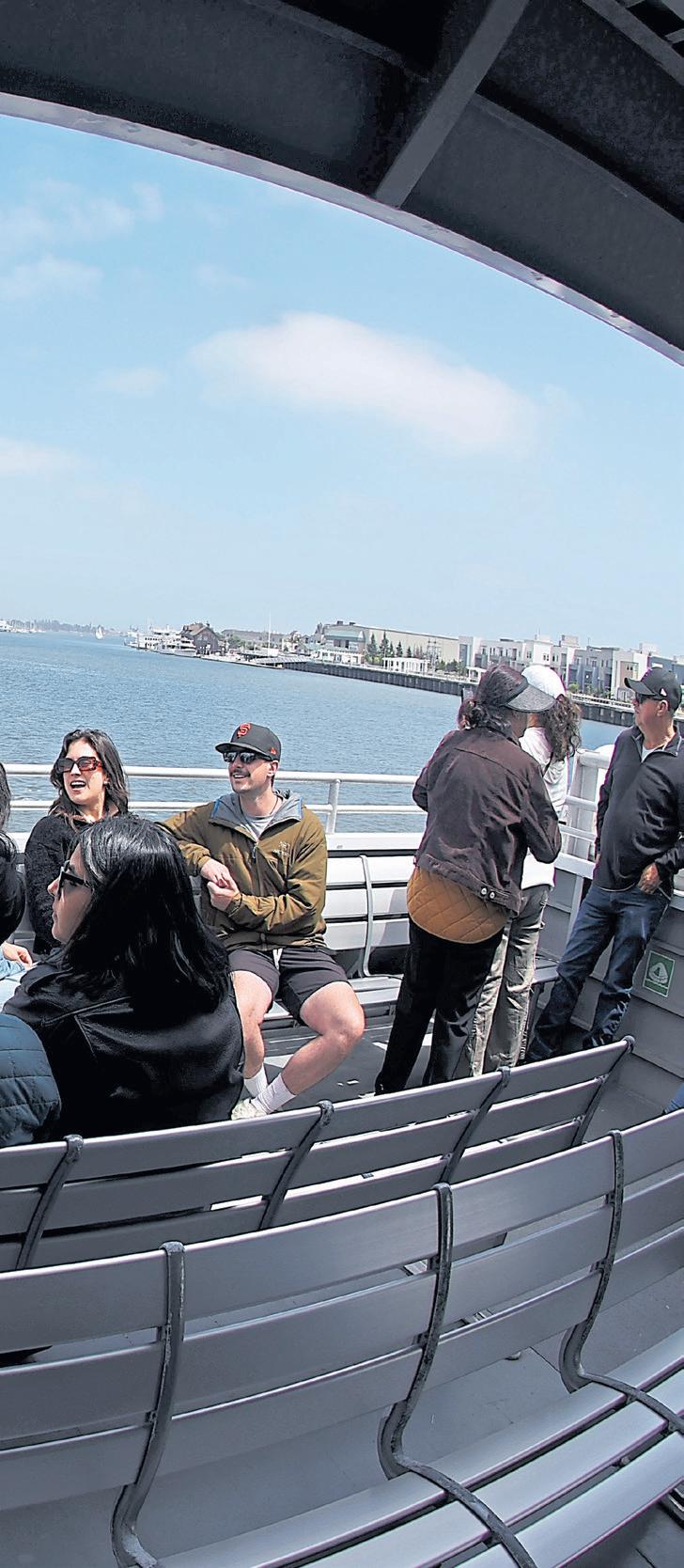


Nevertheless, it’s still a relaxing place to stroll and take in views of the Oakland and San Francisco skylines, kite-sailing thrill seekers and fishers going for stripers and halibut.
Marina Bay Park is a chill spot to watch the yacht action and perhaps relax on the grass with a good book. It’s on the San Francisco Bay Trail, and, if you’ve brought a bike, the trip south through Berkeley and Emeryville is lovely, with a marsh boardwalk and fecund bird habitats. By the terminal is the free Rosie the Riveter museum, which honors the history of Richmond’s workers during World War II. There are exhibits on female welders, wartime rationing and Victory and Liberty ships — at its height, the shipyards here pumped out an amazing one ship per day (1414 Harbour Way South, Suite 3000, Richmond; nps.gov/rori).
Eat and drink: Lara’s Fine Dining is a white-tablecloth restaurant where you might take a first date or celebrate an important anniversary.

It’s a cute Italian joint on the water with comforting dishes like eggplant Parmesan, linguine with clams and always-enticing “catch of the day” (1900 Esplanade Drive, Richmond; larasfinedining. com). Anh Restaurant & Bar prepares Vietnamese dishes such as lemongrass chicken and surf-and-turf pho, with fried-banana samosas for dessert (anhrestaurantandbar. com). Farther away is Golden Gate Bistro with Mexicaninfluenced California cuisine, an outdoor patio and live music on the weekends (803 Wright Ave., #101, Richmond; goldengatebistro.net).
Explore: Many of the ferries originate or transfer at San Francisco’s Ferry Building. Much like an in-airport transfer, there’s not much need to venture beyond the building’s confines, given its abundance of dining and shopping options.
This summer, San Francisco is rolling out “Fridays on Front Street” block parties. These free evening celebrations highlight local bars and live bands curated by Noise Pop Industries — expect lawn games, sportswatching parties and legal drinking in the streets August 22 and October 10; downtownsf. org). The fantastic educational museum Exploratorium is nearby, with its outdoor fog machine and pitch-black Tactile Dome (Pier 15, San Francisco; exploratorium.edu). The San Francisco Railway Museum chronicles the history of the city’s rail-based transit, with a 1911-replica motorman’s platform where you can play with the controls (77 Steuart St., San Francisco; streetcar.org/ museum).
Top: Patrons explore the Ferry Building in San Francisco in September 2022.
DAI SUGANO/STAFF
Bottom: The Rosie the Riveter WWII Home Front National Historical Park in Richmond.
JOSE CARLOS FAJARDO/STAFF
Eat and drink: The team behind San Francisco’s Michelin-starred Sorrel is opening two places in the Ferry Building this summer: the bakery Parachute and the wood fire-focused Californian eatery Arquet (instagram.com/arquetrestaurant). Also opening in the building is Nash Bakes with artisan cheesecakes in flavors such as blueberry lemonade and savorysalmon lox (instagram.com/ nashbakesit). The place to watch diving seagulls and departing ferries is the Hog Island Oyster Co., dishing up grilled oysters, lingcod fish and chips and other delights from California waters, all washed down with local beer and wine (hogislandoysters. com).

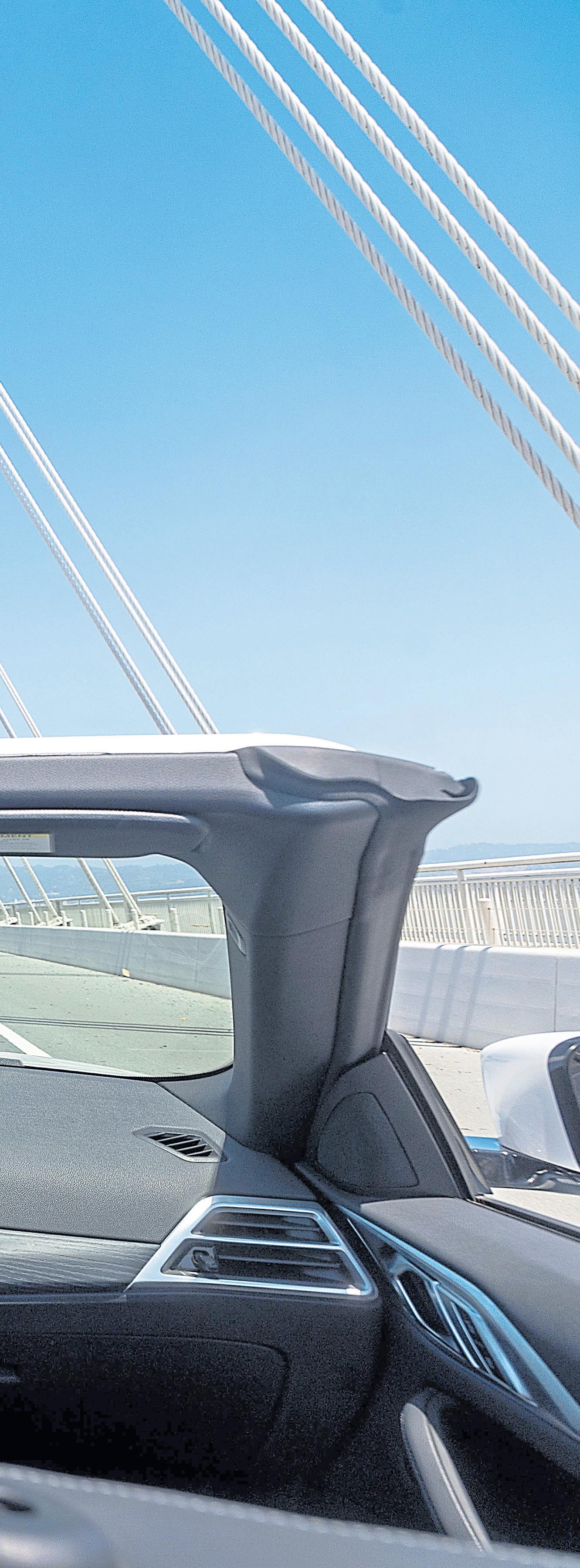
STORY BY KATE BRADSHAW
PHOTOS BY KARL MONDON
Remember the joy of first learning to drive? The way it felt like the world was at your fingertips? The burst of main character energy that came with wheels that could propel you to new cities, new landscapes? The feeling that driving could be fun?
That’s how it felt crossing the Bay Bridge in a rented BMW luxury convertible on an early June afternoon. Surprisingly, compared to many of the Bay Area’s luxuries, renting a sumptuous convertible for the day is a comparatively affordable option. My weekday rental was $126, plus insurance, for 24 hours, as well as the costs of gas and parking.
Here’s how it went.
In all honesty, the day started with a logistical challenge. It’s pretty uncommon, apparently, to show up at the airport car rental hub with a car of one’s own. The rental agency, Sixt, didn’t have on-site parking, so I had to schlep my personal vehicle out to SFO’s long-term parking. With that hurdle overcome, I returned to the hub and slid behind the wheel of my ride for the day: a 2024 BMW 4 Series convertible.

Above: Bradshaw was able to navigate her trip on a center screen and also on a “heads-up display” that appears on the windshield above the steering wheel.

A little anxious about driving the nicest car I’d ever been in, I was determined to see if Barbie and Regina George were really onto something with their signature open-air rigs. My first stop was the Glen Park BART station, where inimitable photojournalist Karl Mondon hopped into the back to document the adventure. We rolled back the top to let the sun in and headed across the Bay Bridge to take in the start-of-summer vibes. Before crossing the bridge, though, I added the rental’s license plate to my FasTrak account, which I was told would help me save a few bucks in extra fees.
First stop: Treasure Island to take in the scenery from Panorama Park, then we picked up a coffee at the charming Aracely Cafe (driving through some industrial streets that had us questioning our directions). Not to sound like a car commercial, but I was quite impressed with the driver-side projection onto the windshield that showed the speed limit and my speed plus radio stations so that I never had to look down at my dashboard. So. Fancy.
We’d both heard the stereotype that folks behind the wheel of BMWs can sometimes drive like jerks. But feeling the smooth
Above: Bradshaw escapes heavy I-280 commute traffic, taking a side road above Crystal Springs Reservoir.
Right: Bradshaw and her cousin, Madeline Bradshaw take down the top on their convertible before going for a drive in Berkeley.





power beneath the accelerator, I finally understood the temptation in a new way. I wanted to gun it and feel the engine purr as I slickly wove through traffic, an impatient but graceful fish in a school of automobiles, all hurtling in the same direction. But old habits die hard, and my defensive Yaris-wielding “No, really, YOU go” tendencies eventually kicked back in.
The next stop was to pick up my cousin Madeline, who recently finished a graduate program at UC Berkeley and was available on short notice during the week to participate in the East Bay portion of this joyride. Our objective was to have a photogenic picnic, so the natural destination was Strawberry Creek Park, where a grassy lawn full of other picnickers and afternoon sun-seekers confirmed we were on the right track. Playful pups chased each other while we sat and cheerfully ate our sandwiches, discussing our plans for the future. There was tofu banh mi for me from Banh Mi Bite, and a Mediterranean chicken wrap for Madeline from My-O-My, a Canadian shawarma joint. Fueled up, we wanted to soak in the sunshine and glorious wind along the Bay, so we headed for the Albany Bulb. As is frequently the case, I-80 through
Top: Exhilaration takes over as Bradshaw and her cousin make their way around the Bay Area.
Sixt Rent-A-Car: Open 6 a.m.-1
a.m. daily at Rental Car Center, 780 N. McDonnell Rd, San Francisco; sixt.com.
Panorama Park: Open 6 a.m.-7 p.m. daily at 66-324 Yerba Buena Road, San Francisco.
Aracely Cafe: Open 8 a.m.-8
p.m. Wednesday-Saturday and 8 a.m.-3 p.m. Sunday-Tuesday at 401 13th St. #312, San Francisco; https://aracelysf.com/
Banh Mi Bite: Open 10 a.m.-5 p.m. daily at 1814 Euclid Ave, Berkeley; banhmibite.com.
My-O-My: Open 11 a.m.-12 a.m. weekdays and 12 p.m.-12 a.m. weekends at 1866 Euclid Ave., Berkeley, instagram.com/my.o.my. shawarma.
Strawberry Creek Park: Open 6 a.m.-10 p.m. daily at 1260 Allston Way, Berkeley; https://berkeleyca. gov/community-recreation/parksrecreation/parks/strawberrycreek-parkberkeleyca.gov.
Albany Bulb: Open 5 a.m.-10 p.m. daily at 1 Buchanan St., Albany.
Crystal Springs Regional Trail: Open daily until Labor Day until 8 p.m. at 950 CA-35, Redwood City.
Alice’s Restaurant: Open 8
a.m.-8 p.m. Monday-Saturday and 8 a.m.-7 p.m. on Sundays at 17288 Skyline Blvd., Woodside; alicesrestaurant.com.
Montara State Beach: Open 8 a.m.-sunset daily; Highway 1, 8 miles north of Highway 92; parks. ca.gov.
A navigation system provides clear guidance as Bradshaw drives down a tree-lined road.


Berkeley was a traffic-riddled mess, but with the wind making Medusa-like tendrils of our hair, we barely noticed. At the park, we took in the kites on the horizon over the hazy city across the Bay and smiled.
After dropping Madeline at her place, we headed across the Bay to our next scenic lookout, the Crystal Springs Reservoir in San Mateo County. On the way, we hit a snarl of traffic on I-880 south. Looking around us, it seemed bizarre. Why aren’t there more convertibles on the road? It’s not like there’s a shortage of luxury cars in the region, but so few are open to the fresh air. I couldn’t understand it. We were having fun, enjoying the breeze and the vibes — and all at rush hour! And then we were crossing the San Mateo-Hayward bridge, flying over the water for what felt like a long time — perhaps because, at 7
miles, it’s the longest bridge in California. Then we turned onto Highway 280 and stopped at a vista point to see the gentle browning hills overlooking the water of the Crystal Springs Dam, fingers of fog poking over the westward mountains. I-280 is part of Caltrans’ official Scenic Highways, which, among other conditions, means that there are no billboards, and nearby development is minimized — ideal conditions for appreciating the Peninsula’s temperate beauty. Enjoying every minute of the golden hour, I dropped Karl at BART and headed home.
But the adventure wasn’t over yet. My sister and roommate, Amy, and our cousin, Sommer, were finally free for the evening and wanted a turn as passengers (obviously). So we ventured out in search of sunset views and dessert in the vague direction of Pescadero, cresting the four cor-
Strawberry Creek Park in Berkeley affords the perfect spot for the cousins to spread a picnic lunch.
ners intersection where Alice’s Restaurant perches, just ahead of closing and in time to order three kinds of cake — molten lava cake, cheesecake and carrot cake. Sated, we reconfigured our route northward instead, taking Skyline Boulevard to Half Moon Bay, then Highway 1 to Pacifica and back to the car rental hub. By now, we’d figured out how to connect our music to the convertible’s audio system, and the party was on. Driving through the winding roads of the Santa Cruz Mountains beneath the redwoods hits you differently when the car is doubling as an open-air karaoke room. DJ Amy queued up on-theme hits, such as Taylor Swift’s “Getaway Car,” Tracy Chapman’s “Fast Car” and Harry Styles’ “Keep Driving.” Between turns along Highway 35, we’d catch the pastel rainbow of the sunset flashing by amid the silhouettes of dense
evergreens. My two passengers, blankets atop their laps, grinned from ear to ear as they sang along, even as the fog thickened and darkness fell.
By the time we hit the coast, the air was crisp, and we felt a world away from our stresses.
The briny smell of the ocean drifted our way as we climbed north, and I felt a sense of calm wash over me. If we’d been visiting during the day, we might’ve stopped to dip our toes into the water at Montara State Beach. As it was, the cold air was starting to bite, and as our windswept hair started to tangle into mats, we realized that there was a distinct possibility that maybe convertible life might feel less exhilarating as an all-day, every-day kind of thing.
As we drove through the yellow-lit bore of the Tom Lantos Tunnel, we shouted a series of feral hollers, each louder than the last, riding past the echoes reverberating through the walls. The scene could’ve been straight from “The Perks of Being a Wallflower,” but as the car coasted into Pacifica to begin the journey to return the car, something in the air had shifted. Summer had started, and it felt good to take a deep breath and lean into the joy of the ride.
In a time when people don’t much “go for a drive” for the fun of it anymore — and for good reasons, carbon emissions and pricey gas among them — it was a pleasure to reconnect with the raw joy of being behind the wheel, to feel fancy for a day and to share in an experience that brought giddy grins to everyone along for the ride. If you’re looking for a way to capture those feelings, renting a convertible for the day might just be the answer.


15 great Bay Area songs to fuel your travels

STORY BY JIM HARRINGTON ILLUSTRATION BY PEP BOATELLA
If you’re going on a road trip, then you’re going to need a proper playlist. It’s just that simple. And we certainly have one for you, filled with cool driving songs, sunny weather tunes and fun party tracks. Of course, there’s a zillion such playlists out there. What separates ours from the others is that we only draw from artists and acts who have strong Northern California ties. So, jump in your ride and turn up our Bay Area summer songs playlist. Here we go:
“Good Vibrations” Beach Boys
What’s SoCal’s signature band doing here? Well, founding member Al Jardine has long called Northern California home. So, we’re claiming the Pride of Hawthorne for this playlist. Plus, we understand it’s a law that the Beach Boys must be included on any summer music playlist and figured we might as well oblige at the very start of the ride with this glorious “pocket symphony” from 1966.
“The Golden Road (To Unlimited Devotion)” Grateful Dead
Going on a long, strange trip? Well, then you are going to need some Grateful Dead on the playlist. And we just love rolling down the highway while listen-
“Circling the Sun” Orange Peels
From their Sunnyvale studios, the Orange Peels created some incredibly memorable music. Yet, the number that has always been nearest and dearest to our heart is this fun, catchy indiepop gem, which is the perfect tune for circling around the Bay on a nice day.
“Free Your Mind” En Vogue
Who’s that in the backseat of the convertible? Well, nobody, actually. But we can pretend it’s the superb Oakland vocal troupe En Vogue as we crank up those sweet harmonies on this essential 1992 soul-pop number.
“Dirt On My Boots,” Jon Pardi
Here’s a good T.G.I.F. country rocker that will put a little fuel in your tank when the work week is done and it’s time to play. It’s served up in fine fashion by Pardi, a Dixon native who was inducted into the Grand Ole Opry in 2023.
“Zero to Sixty in Five,” Pablo Cruise

The megahit “California Love” by rapper Tupac Shakur lands on our Bay Area road trip playlist, thanks largely in part to the line, “from Oakland to Sac-town, the Bay Area and back down.”
FRANK WIESE/ ASSOCIATED PRESS FILE

ing to this glistening Summer of Love classic from the ultimate Bay Area jam band’s first album.
“Drive,” R.E.M.
Surprised to see Georgia’s finest on the list? Well, maybe you don’t realize that guitarist Peter Buck hails from Berkeley. So, buckle up and groove along with this appropriately entitled rocker from 1992’s “Automatic for the People.”
“California Love” 2Pac
You just know we’re bringing some Pac on this trip. So, let’s go cruise — “from Oakland to Sac-town, the Bay Area and back down” — with one of the best hip-hop party anthems of all time.
Possibly the most underrated Bay Area band of all time, Pablo Cruise is most often lumped into the smooth yacht rock realm. And they certainly did excellent work in that subgenre. Yet, the group also delivered some absolutely smokin’ rock instrumentals, such as this road trip-friendly winner from 1976’s “Lifeline.”
“Take the Skinheads Bowling” Camper Van Beethoven
You need a good joyous singalong on a road trip — preferably one where singing loud is far more important than singing on key. And this goofy alt-rock classic from Camper Van Beethoven (which spent time in both Santa Cruz and San Francisco) certainly fits the bill.
“I Can’t Drive 55” Sammy Hagar
A little too on the nose for a roadtrip setlist? Maybe, but you won’t
care as you rev on down the highway to the sound of the Bay Area’s Red Rocker in his prime.
“Callin’ Out” Lyrics Born
The Berkeley rapper’s signature tune just never seems to get old. On the contrary, we often like to play it two or three times — in a row. So, hit the highway with nothing short of one of the grooviest hip-hop tunes to light up speakers over the last 25 years.
“Go Your Own Way”
Fleetwood Mac
Lindsey Buckingham, a Palo Alto native and former San Jose State student, wrote and sang lead on this hard-driving rocker on Fleetwood Mac’s legendary 11th album, “Rumours.” Just think about how many people cranked up this number in their cars back in 1977, the year that “Rumours” spent a staggering 29 weeks at No. 1 on the charts.
“You Learn”
Alanis Morissette
Alanis Morissette, now a Bay Area resident, contributes her hit “You Learn” to our Bay Area road trip playlist.
EDUARDO VERDUGO/ ASSOCIATED PRESS
The Canadian alt-rock icon, who now calls the Bay Area home, has a ton of great driving tunes. Yet, the one we really like to turn up is this empowering anthem, which helps us realize that it’s perfectly normal to make a few wrong turns now and again.
“Shiny Happy People”
R.E.M.
R.E.M. is a favorite American band, so they get two spots on the list. Of course, we know that a lot of fans think this pop song is rubbish. But listen to this joyously sweet single in the convertible, with the windows down and the system up, and you’ll realize those people are wrong.
“Somebody to Love”
Jefferson Airplane
We’ll bring the road trip to a close with the voice of Grace Slick — arguably the greatest Bay Area rock vocalist of all time — and this ultimate Summer of Love anthem.
Bay Area designer built his name creating popular hand-stitched caps

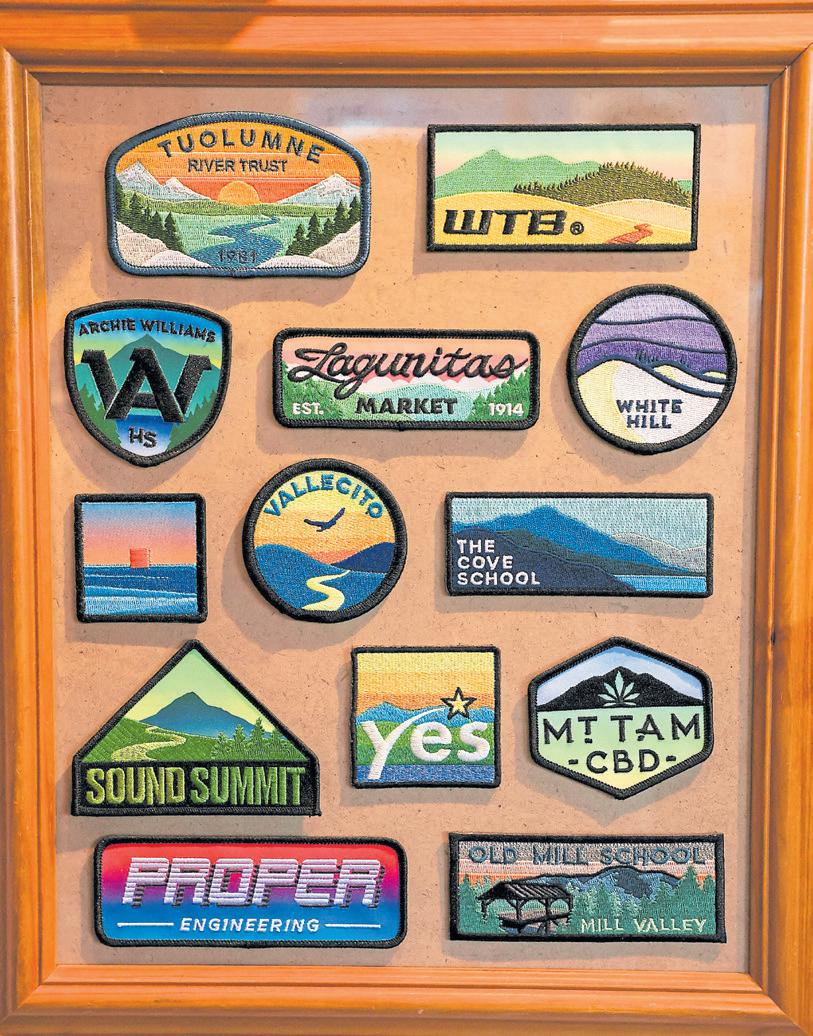
STORY BY JIM HARRINGTON
PHOTOS BY RAY CHAVEZ
Having grown up playing baseball in the summer heat, Tommy Breeze was certainly no stranger to hats.
“I’ve been wearing hats since I was a very little kid,” the Fairfax native remembers. “But for a long time, I would just wear hats while I was playing baseball.
“Then something switched.”
And how.
These days, hats are a huge part of Tommy Breeze’s life. In fact, they’re what he’s known for — as a successful designer of his own eponymous line of trucker, snapback, soft top and other hats, caps and beanies that have been worn by Lady Gaga and other notable personalities.
But what switched to take him from an occasional hat wearing, baseball-loving kid to pursuing a career in hat couture?
“I actually started wearing hats because I was always self-conscious about how my hair looked without a hat on,” says Breeze, who really got into headwear during his days at Whitman College in Walla Walla, Washington. “I was like, ‘it’s going in every direction.’ And then I was like, ‘Just put a hat on, and it kind of gets everything in order.”
Yet, controlling his messy mop was really just one of the reasons that deepened his appreciation


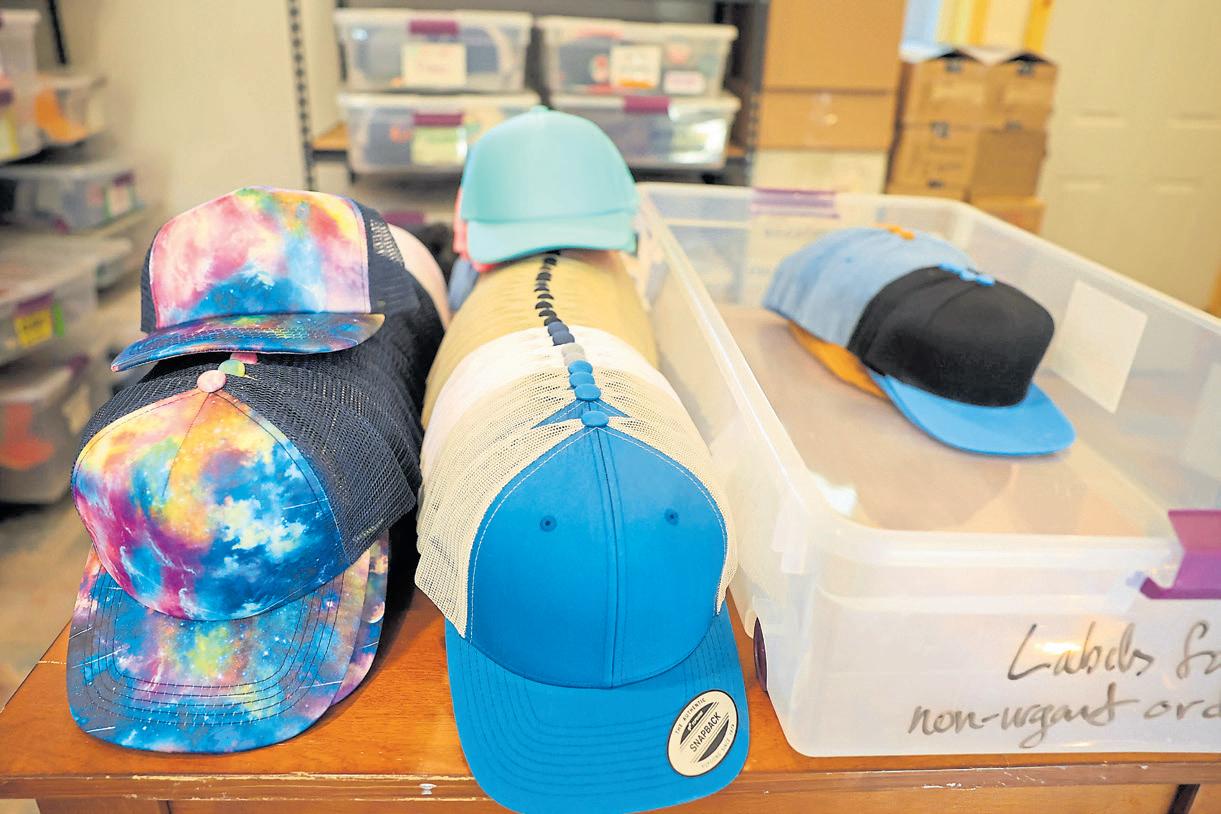
for hats, and how they dress your head for comfort, fashion and almost any kind of weather. He also came across a few really special hats that became very near and dear to his heart.
He found the first at a thrift store in Walla Walla, and Breeze — yes, that’s his real last name — just loved how it not only hid his self-described “weird” hair but also accentuated his personal fashion.
The second was a corduroy cap he picked up during a giveaway promotion at a San Francisco Giants game.
“It fit me so perfectly,” Breeze says of the beloved freebie. “The hat just really spoke to me.”
Then a friend borrowed that Giants lid, and for a while,
transfer it to a patch that could then be placed on a hat — again, just for himself.
“I just wanted one hat — that was it,” Breeze says. “But I realized that when you’re ordering patches, you pretty much have to order 50 or 100 from the factory. Because they aren’t going to make a one-off for you. And, if they did, it would cost several hundred dollars.”
He went ahead and ordered 50 patches — but the manufacturer ended up sending 100. So, he took the excess and decided to make a bunch of hats — hand-sewing his patches on premade hats — in the hopes of making back his initial investment.
It was a lot of work. But he loved it.
“Very quickly, it became obvious that I really enjoyed making the hats,” he says. “I really enjoyed stitching the patches on by hand. It was tough at first. There’s a steep learning curve. But I really enjoyed the activity of customizing hats. And my friends really dug them, too. So, I just kept doing it.”
Top left: Tommy Breeze, owner of Tommy Breeze Company, sports one of the hats he designed at the California Cowboy clothing store in Fairfax. Bottom left: Hats wait for patches to be sewn and designed by Tommy Breeze, owner of Tommy Breeze Company, at his studio in Fairfax.
Tips for choosing the perfect hat, no matter your age or style
Comfortable on your head: “That means looking at the crown shape,” Breeze says. “And also seeing what width and shape of brim is perfect for you.” That’s good advice, since — clearly — a comfortable hat is one you’ll want to wear more often.
Good fabric: “You also want to look for a hat that is premium quality,” Breeze says. “You want to have high quality fabric.” Like with any other article of clothing, a hat that utilizes high quality fabric will likely weather the years better.
Breeze was left without his favorite way to hide his hair. And that brought him to the realization that finding a good hat — the right hat for a specific individual — can actually be a tricky proposition.
“Back then it seemed difficult to find an awesome hat,” he says. “Like, ‘How do you track down the perfect hat for you? Where do you even start with that?’ You don’t even know, as a person out there, what your options are.”
So, he decided to design and make his own hat — just for himself. At the time, he had been doing small paintings — usually of cypress trees — and then putting them onto small buttons to wear. So, the goal was just to take a similar design and
Starting out by posting just a half-dozen of his hats on Instagram in 2018, Breeze quickly saw demand grow. By the end of the first year, the aspiring hat kingpin had hand-stitched 1,000 lids.
These days, he’s doing at least that on a monthly basis, with annual sales for his Fairfax-based company heading toward 20,000 hats. He leads a team of sewists in creating a wide variety of hats, featuring a number of different California-inspired designs, which are sold at retailers around the Bay Area and beyond.
“We are still scaling,” Breeze says of the company’s growth over the years. “We’re still keeping it smaller, so we grow at the right pace.”
A list of retailers can be found on his website — tommybreeze.com, where hat lovers can also place orders themselves.
The patch is it: “What really gets me excited is the patch design,” says Breeze, who started out in the business by hand-sewing the patches he designed onto hats.
Special connection: “It’s not a matter of any scientific approach, or any specific feature,” Breeze says. “It’s about making your own connection with your own hat. And finding that love that lives in that relationship between you and what you wear. ...Maybe it’s because you love the fit of the hat. Maybe your favorite thing is the patch and how it speaks to you and how it helps you channel your happy places in the outdoors.”
Taking ownership: “If you purchased a hat from me, it’s not my hat anymore, it’s your hat now,” he says. “It is a Tommy Breeze hat — yes. But more importantly, it’s your hat.” And wear it as such.
A day in the life of a Bay
‘It’s a movement’
STORY BY JASON MASTRODONATO
PHOTOS BY DAI SUGANO
The sun is warm, soon to be hot, and the smell of sunscreen is in the air.
It’s 9 a.m. on a Friday morning, and a group of eager birders has gathered around its excited leader, Diann McCoy, who is giving out instructions about the adventure that lies ahead.
Bathroom here, she says, water station over there. Shorebirds all around us.
“If you see a bike,” McCoy says, “make sure you yell, ‘bike!’”
Most of those gathered at the Baylands Nature Preserve — with binoculars and water bottles in tow — are there for a singular reason: to scout out the gigantic California gull colony less than 2 miles up a gravel path.
“It’s become an obsession,” says Dori Faust, who drove to the Palo Alto preserve from San Jose. “I’ve been birding for 2½ years. I’ve compared it to the kids playing Pokemon Go, and they get excited to find a Pokemon. Well, that’s how we feel about finding the birds.”
In 1980, the California gull was rarely found in the South Bay — just 24 were spotted that year. Last year, there were more than 7,000 nests. Later
Bailey,
and
observe a California gull colony during the Santa Clara Valley Bird Alliance’s field trip to Palo Alto’s Baylands Nature Preserve in May.

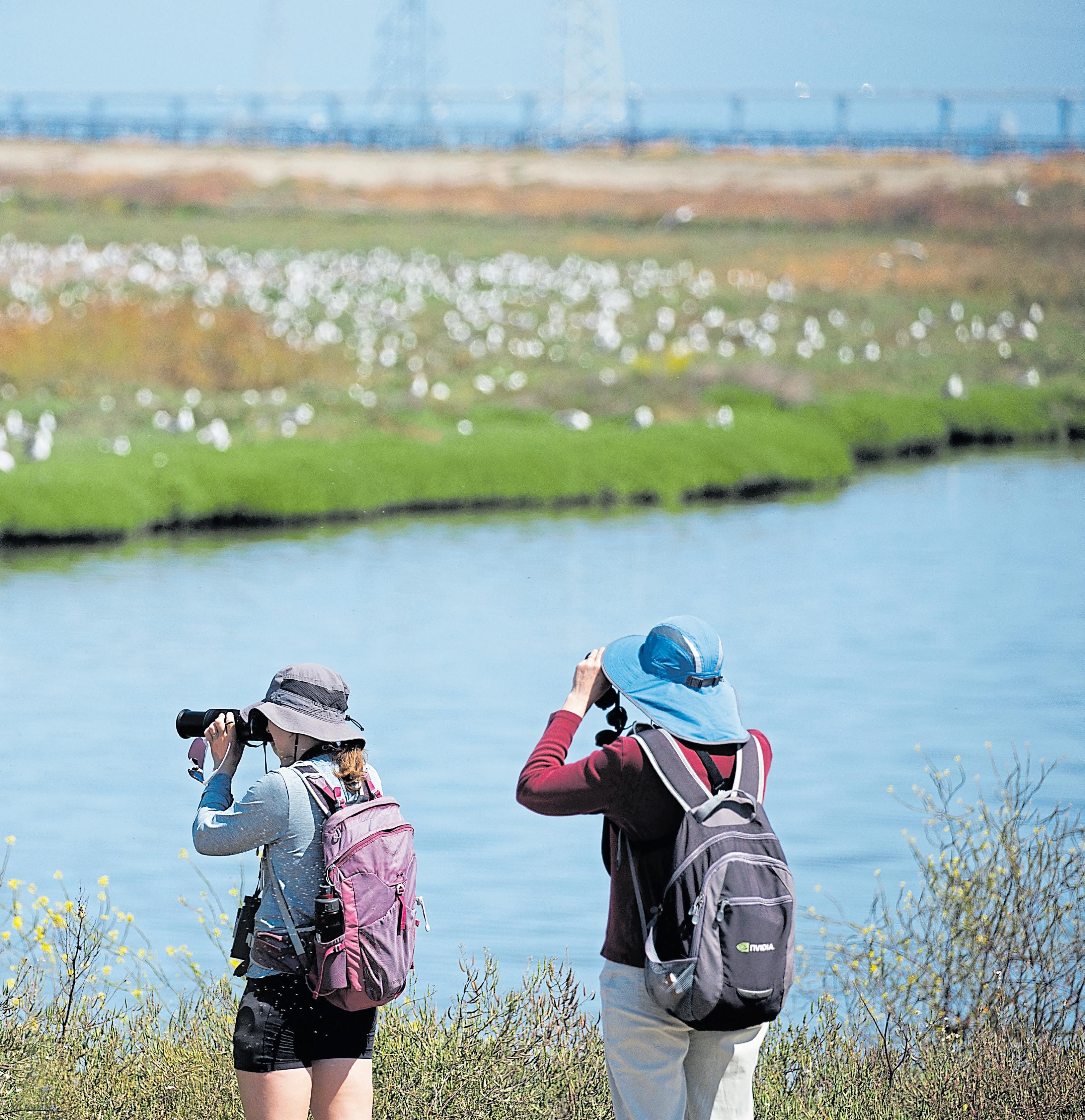
this morning, hundreds will be found on a little patch of land adjacent to a landfill and surrounded by a salt pond.
Poor waste management has been the catalyst in the resurgence in California gull colonies, said Matthew Dodder, executive director of the Santa Clara Valley Bird Alliance. Landfills have reduced the Bay Area’s marshland by 98 percent since the Gold Rush, but the California gulls have thrived.
It’s the appreciation of different species that makes this group of people particularly drawn to bird watching, also known as birding.
There are more than 1,200 members in the Santa Clara Valley Bird Alliance, several of them here this morning, and the journey through the marsh starts with a slow walk.
Having a chat with someone on a bird-watching mission is a game within itself. They’re too in tune with the habitat to truly engage in the conversation.
“It’s not a hobby,” Doddler says. “We like to say that it’s a life choice.”
Within a few seconds, the faint sound of a swallow in the marsh draws the entire group’s attention.
“The swallows are foraging for insects to feed the young,” Dodder says. “These particular places are fantastic locations for birds. This is fresh water that comes in from the hills and drains out through the channel. It gets salty and creates a different habit for the birds.”
Soon, someone spots a duck that looks different from the others, and now everybody has turned their binoculars on the bird. With a quick glance, Dodder makes the identification.
“A cinnamon teal,” he says. “It’s the color of a penny. It was holding its wing open a moment
A savannah sparrow perches on a branch at the Baylands Nature Preserve in Palo Alto.


ago, and it’s sky blue. It’s much less common than the mallard.”
He hands a visitor his binoculars.
“Borrow the binocs so you can take a look,” he says.
As the group oohs and awes over the discovery, Dodder tells a story.
“One time I saw a male cinnamon that was trying to mate with a female mallard, which is twice the size,” Dodder says. “And he was so intent on reaching that goal that he didn’t even notice when I reached down and picked him up.”
It’s the personal stories that connect humans to the birds, he says.
Dodder was just a boy in Brookline, Massachusetts, when he started to wonder how birds find food in the snow-covered winter months. He began to put out seeds and nuts for them to eat.

“Since then, it has become a passion,” he says. “I went to college and went to seminary, then got a fast-paced job in graphic design for 30 years, but the entire time I was interested in birds. I started teaching night classes at Palo Alto Adult School. I had gruesome deadlines at work, but at night, I got to share my relaxing pastime with people.”
At the school he met his wife, Kelly. The two have been married for more than 20 years and frequently go on birding adventures together.
Today’s quest is one he’s done dozens of times, but each time it’s different. A mudflat like this one, he says, could be filled with thousands of shorebirds and multiple species. It changes during the year.
Birds with diets of insects, nectar and pollen breed here during the summer. Migrating birds make a home here during the winter months while navigating the Pacific Flyway.
“There’s always that sense of wonder and discovery,” Dodder says. “And if you’re really competitive, you’re looking for the new bird that you haven’t seen yet this year or the one your friend hasn’t seen.”
Most birders have an eBird account that keeps track of every birding trip and every species they’ve seen. The free app keeps a lifetime score.
“Mine is 349,” Dodder said. That means he’s seen 349 of the 418 species found in Santa Clara County.. “My best year was 2021, when I saw 274. I was pretty eager to catch everything. But it was exhausting. You’re always chasing. You miss dinner with your wife. And the deadline at work somehow slips away.”
Dodder’s story is soon interrupted. All the binoculars are out again. Somebody thinks they’ve made a discovery.
“It’s a black-neck stilt chick!” someone yells.
“Where?!” cry the others.
Fingers are pointing, shoulders are adjusting, and cameras
are clicking.
It’s hard to see, but the tiny chick is there, with an all-gray body, black tail and white feathers that can only be seen if it holds its wings just right. It’s sitting on the edge of the Adobe Creek between two adult stilts, its parents perhaps.
“Oh, now it’s standing back up,” Dodder says. “Oh, it just pooped.”
The group will spend 10 minutes enjoying the sight, a highlight of the visit to the 1,940acre site, as Dodder explains what makes this particular chick unique.
“A lot of shorebirds are precocial, meaning that when they’re hatched, they’re pretty much independent almost immediately,” he says. “Ducks and other birds like songbirds are altricial, which means that they’re helpless. They’re like humans or
San Mateo County Bird Alliance in San Mateo; sequoia-audubon.org.
Golden Gate Bird Alliance in San Francisco and Western Alameda County; goldengatebirdalliance. org/.
Ohlone Audubon Society in Southern and Eastern Alameda County; ohloneaudubon.org/.
Marin Audubon Society in Marin; marinaudubon.org.
Mount Diablo Bird Alliance in Contra Costa County; mtdiablobirds.org.
mammals. They need to be fed.”
While the baby chick looks for food, several mallards hunt nearby. A brown pelican suddenly swoops down into the water looking for its own snack.
“You think, how can they feed simultaneously in the same area without competing?” Dodder says. “The shape of the bill, the length of the legs, you realize they’re not eating the same things. The ones with long bills are probing much deeper down. Some are catching things on the surface, some in deep water, some in the shallow water.
“It’s a nice metaphor for humanity and diversity. Our environment benefits from diversity. Nothing is wasted, everything is utilized.”
Even so, climate change and habitat loss continues to be devastating to most bird populations. Dodder says 75 percent of bird species are in decline and 50 percent of bird chicks die within their first year.
“And when you think about the EPA being defanged by the current administration, it means that even endangered species don’t have the protections they had before,” he said. “And with the preference for development and fossil fuel, that’s only going to get worse.”
It makes groups like the Bird Alliance even more important to conservation efforts. Dodder is one of seven employees paid by the alliance, which operates on grants, donations and member dues. Only three of them are full-time. And when they’re not busy running tour groups, providing educational videos and self-guided tours online or leading educational courses and field trips for local elementary school students, the staffers are
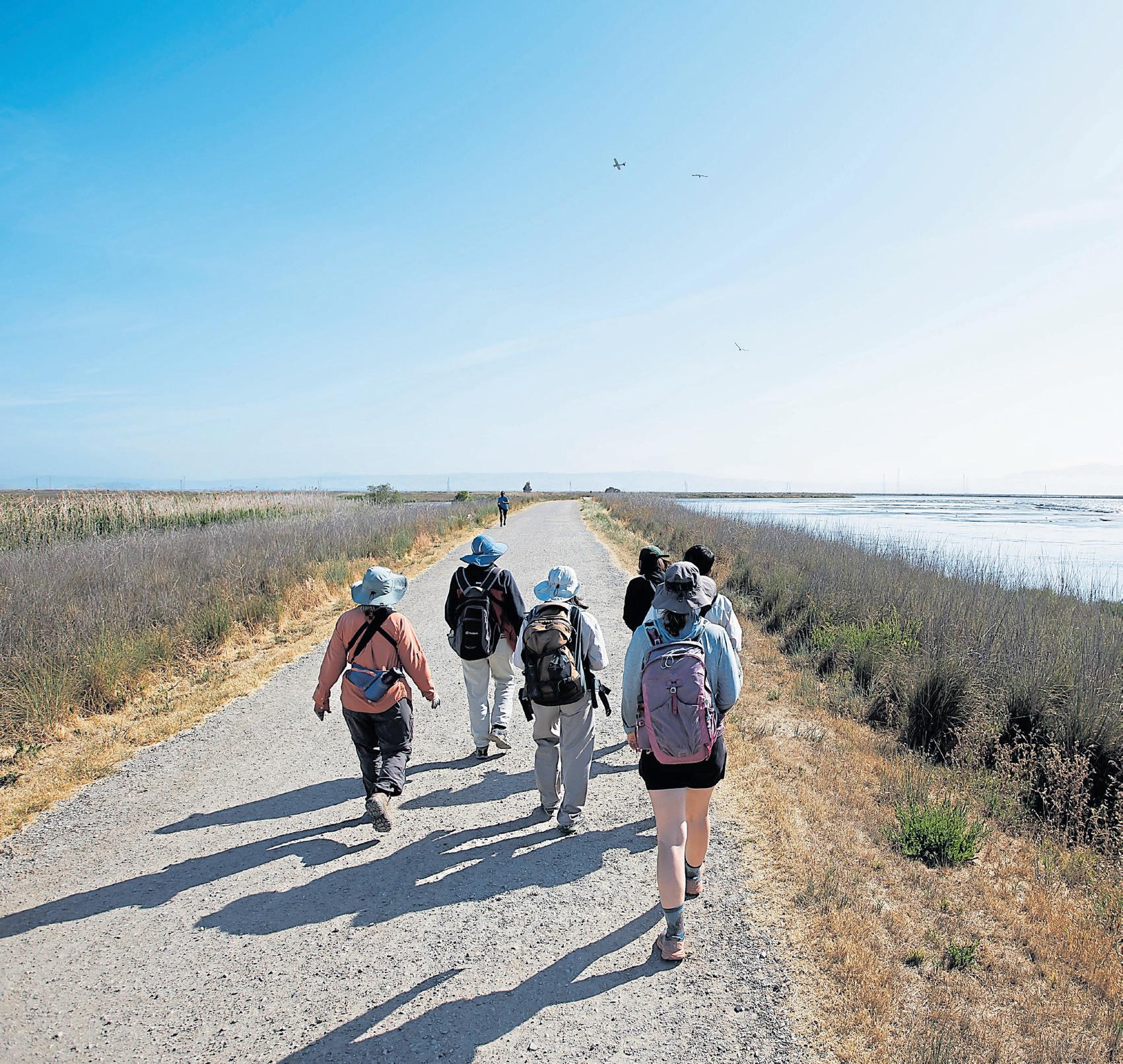
busy working with city officials.
“We have a huge advocacy arm, so we take on large, politicized proposals with science-based arguments against those proposals or for other proposals,” he says. “It’s not just the ecology that’s lost. It’s what we’re giving to our children. What are they going to inherit? They’ll inherit a Bay Area with no animals.”
The organization also is currently fighting to keep the city skies dark at night, a necessary ingredient for nocturnal birds to safely move from place to place.
“But we need more people, we need more volunteers, and we need more financial support,” Dodder says.
As the group makes its way towards the gull colony, Dodder stops to point out some other
discoveries.
A Northern harrier, formerly known as a marsh hawk, flies low and hunts for small rodents by sound. This separates it from a red-tailed hawk, which is a high-altitude soaring bird that uses eyesight to dive down to hunt, or a falcon, which hunts for birds in flight.
A snowy egret flies by. These birds were nearly extinct in the late 1800s because their wispy plumes were popular in ladies’ hats. A few advocates brought it to the attention of the public, and the first Audubon Society was formed.
There are American white pelicans and brown pelicans resting in the Charleston Slough to the east, though Dodder explains that the brown pelicans are having a “horrible year.”

“Warm water is not very good for bait fish and other foods that seabirds rely on, so when you have warm water, it can be really hard for the seabirds to survive the nesting season,” he says. “So the pelicans are dying in large numbers.”
A few double-crested cormorants bathe in the slough. A great egret flies by.
Dodder can tell it’s not a snowy egret, because “the wingbeats are slower,” he said. “The bill is yellow as opposed to black. It’s a bigger bird, twice the size.”
Finally, the group spots its treasure: the California gull colony.
McCoy, who helped carry a telescope and 4-foot stand all the way there, sets up the scope for folks to look at the gull chicks.
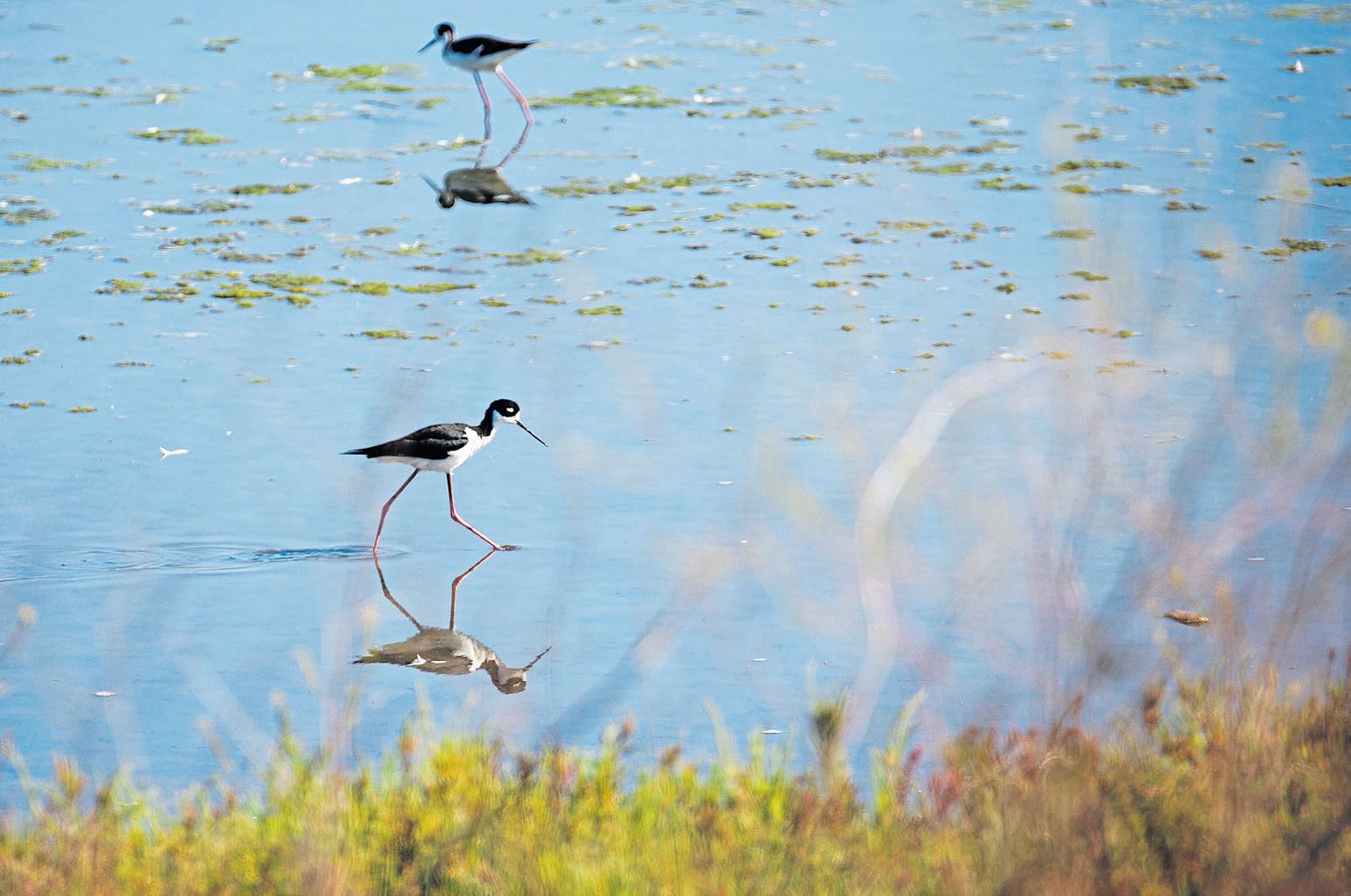
Even the most casual observer could appreciate the sight ahead: hundreds of gulls sunbathing on a small patch of grass and some on the edge of Soap Pond. They gather in large numbers and often move together.
A swarm of insects flies above them, and suddenly dozens of gulls start flying with them, mouths open, feeding themselves and their baby chicks.
“Look at that!” McCoy yells, and the group suddenly shifts their binoculars.
Among the gulls are a few American white pelicans, one double-crested cormorant and the occasional mallard.
“If I were a gull and a chick, I would be concerned that the pelican would happily eat a small gull,” Dodder says.
The bird enthusiasts will spend at least a half hour here, studying every detail of the gull colony.
Notably, cell phones are in
Black-necked stilts can be seen from the Adobe Creek Loop Trail at the Baylands Nature Preserve in Palo Alto.
their pockets. Work deadlines are forgotten. Stresses are left behind.
As much as they’ve come for the birds, they’ve also come for the peace.
“This is only my second field trip,” said Claire Bailey, 28, whose interest in birds was almost a direct counter-reaction to the burnout from the pressures of modern society.
She read a book, “How to Do Nothing,” by Jenny Odell, and “it’s kind of a rejection of the go-go-go work attitude, that we’ve got to be productive all the time. That sparked the interest.”
Bailey has a law degree but decided to take a more relaxing job at a library until she moves back to her native Australia sometime next year. Hanging out with birds has been a meditative experience.
“It’s so easy to just be here, listening, looking,” she says. “It’s also a very slow activity. I used to go hiking, and you’d be walk-
Matthew Dodder of the Santa Clara Valley Bird Alliance offers these tips for beginning birders:
Join a beginner-friendly trip.
Watch SCVBA educational videos (https://www. youtube.com/channel/ UCw65RGDsD7TsUW6jSf_ W7sQ).
Buy or borrow a pair of binoculars. “We have binoculars that we hand out on some of our walks,” Dodder says.
Download the Merlin app (for avian identification) and make an eBird account (to track your bird tally).
Get a field guide.
ing pretty fast, but here, you’re just slowing down, noticing what’s around you.”
She’s piqued her partner and friends’ interest in birding, too.
“I feel like we’re sparking a little something,” she says. “It’s a movement.” Call it a movement. Call it a hobby. Call it a life choice. Or call it a breezy Friday morning in Palo Alto.
Details: The Santa Clara Valley Bird Alliance offers two to three field trips a week, most open to the public, in Santa Clara Valley; scvbirdalliance.org. The Baylands Nature Preserve, one of the largest undisturbed marshlands in the Bay Area, offers 15 miles of trails amid tidal and freshwater habitats. Parking is free along Terminal Boulevard near the intersection with San Antonio Road.

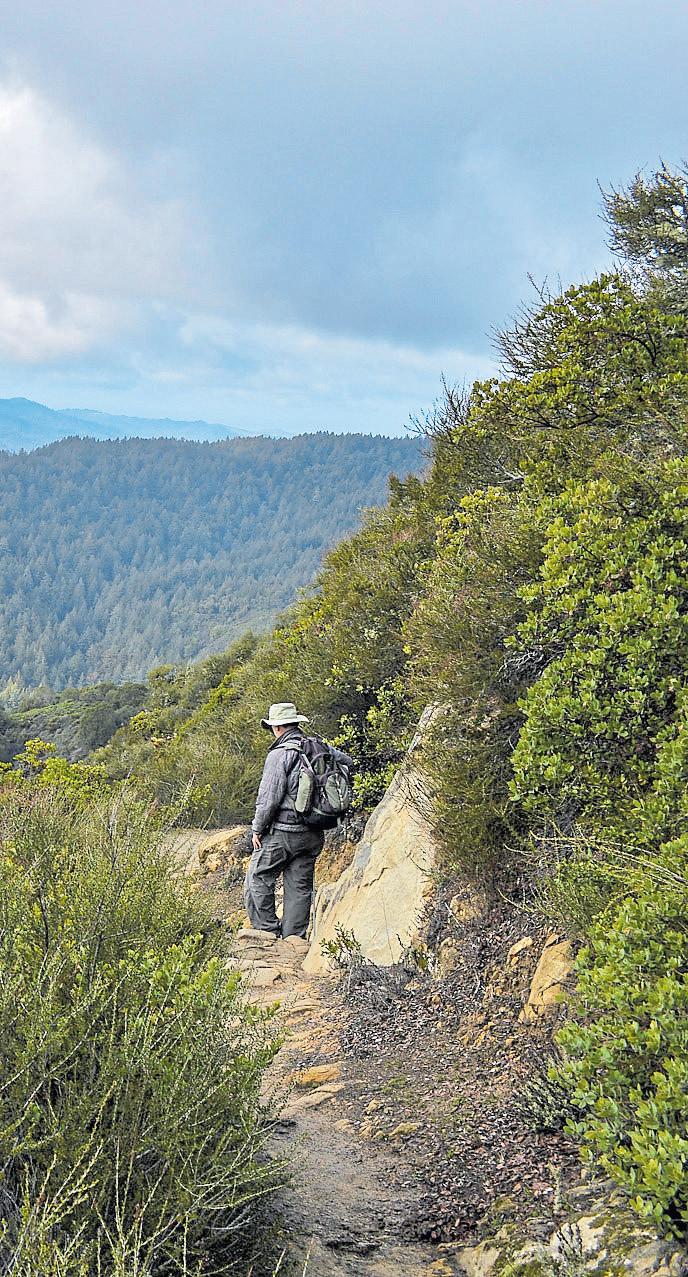
BY MARTHA ROSS
During the Bay Area’s glorious summers, residents and visitors alike love to get out in nature, sometimes on leisurely local strolls or with a little preparation, serious hikes where various terrains and micro-climates are on offer. Here are some favorite hikes to enjoy that variety and avoid the more scorching inland temperatures.
COAST TRAIL FROM BOLINAS INTO POINT REYES NATIONAL SEASHORE
If the Bay Area falls under another weeks-long “heat dome” like last summer, your best chance for relief is to head to the ocean. The some 200 miles of coastline from Santa Cruz to Sea Ranch offer countless opportunities to catch cool Pacific breezes while hiking along towering cliffs or down to hidden beaches.
This approximately 6-mile, out-and-back hike into Point Reyes National Seashore provides cliffs, breezes and a potential beach opportunity plus also something unique to the Bay Area: the chance to visit a picturesque, naturally occurring lake — not a human-made reservoir — in the middle of a lush forest. This body of water, Bass Lake, also is a not-so-secret swimming spot.
The hike starts at the Palom-
Rock State Park is one of the top destinations for climbers and hikers in the South Bay, with more than 5000 acres to explore in the Santa Cruz Mountains.
arin Trailhead, approximately 5 miles northwest of Bolinas. The trail initially passes through a grove of eucalyptus with extravagantly intertwined trunks before coming out into the open along the top of a bluff, high above the churning Pacific. On days when inland temperatures exceed 100 degrees, nature provides its own air-conditioning in the form of wisps of fog blowing up from the ocean.
The hike dips down into a valley before crossing a bridge and switchbacking up the other side and over a pass that brings you into a forest that is part of the Phillip Burton Wilderness. You’ll pass several small ponds before reaching Bass Lake. An unmaintained spur trail winds along the northwest side of the lake, a nice spot for a picnic near the water. Park staff, however, warn that access to the lake is limited, as its shores are largely surrounded by thick tangles of vegetation, including poison oak. There are no lifeguards, so “swim at your own risk,” rangers say.
Hikers can continue along the Coast Trail to other popular destinations. For an ambitious 13-mile roundtrip, you’ll pass by Pelican Lake, another naturally occurring body of water, before reaching dramatic Alamere Falls. Here, water cascades over a 40-foot cliff onto a small beach below, but rangers warn that the beach is only accessible at low tide.
Details: For day visitors, the park is open 6 a.m. to midnight, year-round, and there is no fee. The Palomarin Trailhead is at the northwestern end of Mesa Road; the last 1.2 miles of Mesa Road is unpaved and severely potholed. There are portable toilets at the trailhead but no water, so be sure to bring your own. https://www. nps.gov/
And afterward: Head south on Highway 1 to Stinson Beach and the Parkside Cafe, where the beachside snack bar has been serving hamburgers, hot dogs, shakes and its famous half ‘n half soft ice cream cones since 1949. There’s also a

sit-down restaurant, serving breakfast, lunch, dinner and cocktails, with an emphasis on seafood dishes; www. parksidecafe.com
Thanks to conservationists, the Bay Area is home to more than 40 parks where you can immerse yourself in forests of coast redwoods, those giants that grow taller than skyscrapers, nurture entire ecosystems and live for centuries. These forests also offer acres of shade and gentle, cool breezes on hot summer days.
Some of these parks are wonderfully close to civilization. In the hills between Oakland and the East Bay suburbs, Dr. Aurelia Reinhardt Redwood Regional Park is a lush, 1,833acre strip of forest made up of
Above: The Stream Trail is part of the magnificent network of trails in Reinhardt Redwood Regional Park in Oakland.
JOSE CARLOS
FAJARDO/STAFF ARCHIVES
Opposite: The Rocky Ridge View Trail in the Las Trampas Wilderness Regional Preserve near San Ramon.
ARIC CRABB/STAFF
second- and third-generation clones of ancient trees that were lost to clear-cutting in the 1800s to support the booming Bay Area’s need for timber. Still, this forest is magnificent, accented by ferns, grasses and flowering plants that come in infinite shades of green.
A popular route is the French Trail Loop. It starts at the Canyon Meadow Staging Area and can go on for 4 to 6 miles, depending on which connector paths you choose. Any version, though, begins with a pleasant, mostly level stroll along the Stream Trail, which follows the course of Redwood Creek.
For a redwood park that is much more remote, try Portola Redwoods State Park, nestled deep in the Santa Cruz Mountains. Two narrow winding roads from Skyline Boulevard take you down into a forest, where you may find near-total
silence as you follow meandering creeks and pass through some of the Bay Area’s oldest redwood trees
An easy 1.2-mile roundtrip hike leads to Old Tree, which is more than 300 feet tall and estimated to be more than 1,200 years old. This hike spotlights trees with charred trunks that survived forest fires centuries ago — and which continue to thrive. For the much more ambitious, there’s a nearly 12-mile trek into Peters Creek Grove, nestled deep within the park and consisting of mammoth, old-growth redwoods.
Details: Reinhardt Redwood Regional Park, at 7867 Redwood Road, Oakland, is open to day visitors from 8 a.m. to 8 p.m. through the end of September, with a $5 vehicle day-use fee. www.ebparks.org/. Portola Redwoods State Park, off Alpine Road and at the end of Portola State Park Road, is open to day visitors from 6 a.m.

to sunset with a $10 vehicle day-use fee.
And afterward... From Reinhardt Redwood Regional Park, head to the Fourth Bore Tap Room in Orinda’s Theatre Square for craft beer and hearty pub fare, including Angus steak skewers, pulled pork nachos and pizzas and live music on weekends. https://thefourthbore.com. For Portola Redwoods State Park, you’ll need to travel back into civilization for a meal. The closest option is Alice’s Restaurant, a favorite destination for hikers, bikers, artists and entrepreneurs. It serves gourmet burgers, scrambles, housemade pies and local wines and beer. Open daily at 17288 Skyline Blvd. in Woodside; www.alicesrestaurant.com.
For nearly a century, massive sandstone outcroppings and rock walls have offered tantalizing destinations for serious climbers at this 5,200-acre state park in the Santa Cruz Mountains. Don’t worry: You don’t have to be one of those diehards to enjoy these attractions, though a 3-mile loop to the top of dramatic 2,920-foot Goat Rock still requires scrambling over big rocks.
Of course, the views from Goat Rock are worth the effort. On a clear day, you can see the mountains that are the home to Big Basin, Butano and other state and county parks, along with the San Lorenzo River Valley to Monterey Bay and the blue Pacific Ocean beyond. The hike to Goat Rock, along the Saratoga Gap Trail, will also take you past another popular park attraction: Castle Rock Falls.


The trail descends a little over half a mile through a forest of oaks and mixed evergreens to Kings Creek, a tributary of the San Lorenzo River. After crossing the creek at a footbridge, continue left along the trail, which takes you to a viewing platform for the falls. When Kings Creek is still flowing, it drops some 75 feet into a canyon below. From this platform, you might also catch climbers attempting to ascend the sheer rock face.
Continuing along the trail, the tree canopy gives way to open scrubby chaparral, low manza-
Flowers bloom along the side of the Elderberry Trail at the Las Trampas Wilderness Regional Preserve near San Ramon.
ARIC CRABB/STAFF
nitas, breezes off the ocean and a view of the final destination: Goat Rock. No, this outcropping doesn’t look like a goat, but it’s still pretty distinctive: some 100 feet tall from its base and pocked with deep cavities. The trail here becomes more challenging, running up and over sandstone boulders that protrude out of the side of the mountain and require balance, thigh power and resistance to acrophobia. At about 1.4 miles, you can take the Interconnector Trail up to the Ridge Trail, which winds through black oaks to the top of Goat Rock, with its panorama of mountains, sky and ocean.
Details: The park’s main entrance, at 15451 Skyline Blvd., is open 6 a.m. to sunset, with a large parking lot and a $10 vehicle day-use fee. Here, there are restrooms, a native plant garden and a
.08-mile path from the parking lot that leads to an ADA-compliant picnic table with woodland views.
And afterward… Drive down the mountain from Skyline Boulevard and stop in picturesque Saratoga and Sue’s Gallery Cafe, which serves vanilla lattes, Aztec mochas and a variety of teas and artfully created toasts and flatbreads, topped with avocado, mascarpone cheese or ham and pesto; https:// suesgallerycafe.com
TRAIL TO ROCKY RIDGE, LAS TRAMPAS WILDERNESS REGIONAL PRESERVE
On a sun-scorched day in the middle of summer, you’d frankly want to avoid many hikes in the East Bay hills — unless you started in the cool early morning or you’re one of those Death Valley marathoners.

But on a mild day, the Elderberry Trail hike to the top of Rocky Ridge in Las Trampas Wilderness Regional Preserve offers a pleasantly strenuous climb through cool, shady groves of oaks and buckeyes and the promise of stunning views at the top. Once you’ve ascended to long, open Rocky Ridge, you can gaze upon the surrounding wildlands and beyond — the Santa Cruz Mountains, San Francisco Bay and the city skyline in the west; Mount Diablo to the east; and Livermore Valley and the craggy peaks of Sunol Regional Wilderness to the south. Whether the ridge is enshrouded by summer fog or bathed in sun, you’re likely to encounter brisk winds blowing in from the Bay
Above: Rocky Ridge in Las Tampas Regional Wilderness Preserve.
COURTESY OF EAST BAY REGIONAL PARK DISTRICT
Right: Bass Lake, a popular though unofficial swimming spot at Point Reyes National Seashore, can be reached via the Coast Trail.
MARTHA ROSS/ STAFF

and Golden Gate.
The Elderberry Trail can be the first leg of a popular loop that is roughly 5 miles long. From the staging area at the end of Bollinger Canyon Road, this wide dirt tract ambles south for about a half mile along Bollinger Canyon Creek, next to a pasture populated by grazing cattle. It veers right for a short, intense climb before it follows a somewhat more steady wind up to the ridge.
You have the option to follow the Rocky Ridge Trail for another mile and a half and enjoy more of those commanding views before it loops back down onto another fire road. But from the top of the ridge, you can also take a side trip. The most popular is a strenuous hike down about 700 feet into a box canyon, via the Devil’s Hole or Sycamore trails, and then back up. This trail will take you past rock formations, including “a wind cave,” which are remnants of prehistoric sea life. While spring is the best time to see an array of wildflowers in Las Trampas, hikers have reported seeing poppies and lupines in the early fall.
Details: Through Sept. 3, the park is open from 8 a.m. to 8 p.m. and then open to 7 p.m. through Nov. 1. The staging area and parking at the end of Bollinger Canyon has restrooms, picnic tables and water fountains. There is no charge for parking. Cell service is spotty here, so download any maps or pick up a free paper map before hitting the trail, www. ebparks.org
And afterward… Enjoy a sweet treat at Salt & Straw, the artisanal ice cream shop in San Ramon’s City Center that is known for adventurous flavors like chocolate chili crisp, pear and blue cheese and, our favorite, lavender honey; https://saltandstraw.com/


STORY BY STEPHANIE LAM
PHOTOS
BY
DAI SUGANO
San Jose resident Jim Challas only needs three things to play his favorite outdoor game: a green space, a sunhat and — most important of all — a plastic disc.
On a recent windy May day, Challas pulls several of them out of the trunk of his car at Kelley Park in San Jose. He lines them up on a nearby picnic table, each sporting a different color and size, and describes their unique functions.
“This one’s just excellent for slicing through the air,” Challas says, holding a small, translucent disc in his hands.
But the 73-year-old isn’t going to aimlessly toss the disc into the park’s landscape or towards someone’s awaiting hand. Instead, his eyes fixate on an elevated metal basket stationed hundreds of feet away from the table. Challas carefully positions his body towards the target, pulls back his right wrist and then releases the frisbee with a mix of force and finesse.
His intention is simple: to score the frisbee into the basket in the smallest number of throws, while navigating through a prickly terrain of trees, dried grass and shrubs.
That’s the art of disc golf, a growing sport that’s sweeping through the Bay Area. It’s a unique twist on regular golf, except players use various types of colorful flying discs instead of clubs and balls to reach
the hole. Disc golfers rely on a mix of frisbees, hand-throwing techniques and good weather conditions to help them land a solid shot.
There are formal disc golf clubs in the East Bay, South Bay and San Francisco — all of which boast hundreds of members and thousands of followers in their respective Facebook groups. San Jose is even ranked as the 20th best disc golf destination in the state by the sports app UDisc, while San Francisco is ranked 29th.
One of the biggest clubs in the area is Silicon Valley Disc Golf, which has more than 250 members, according to Challas, and more than 3,000 users in its Facebook group. Each week, enthusiasts post flyers on local disc golf fundraisers and tournaments, advice on how to improve their skills and videos of frisbee trick shots.
“We get hundreds and hundreds of people that play out there,” said Challas, who is also president of the club. “It’s a positive thing for the community, at a low cost.”
The first official disc golf course was created in Pasadena, California, in the 1970s. The sport quickly gained momentum across the U.S. — tournaments began popping up in major cities, locals formed recreational and competitive groups; and disc golf classes began appearing in school curriculums.
Now, an estimated eight to 12 million Americans have played disc golf, and more than half a million play regularly, according to the Professional Disc Golf Association, which oversees the rules of the game and monitors more than 300,000 members.
Disc golf data reveals that the sport is especially growing in popularity among millennials and Gen Zers. The 18-to-34 age group makes up 43 percent of

all disc golfers, while those aged 35 to 54 account for 39 percent, according to Kansas-based disc golf business STM Disc Golf. The remaining 18 percent are over 55, like Challas.
He not only witnessed the rise of disc golf in the 70s, but also helped pioneer the sport in the Bay Area. The award-winning golfer has participated in championships and invitations hosted by PDGA, connected communities of players across California and spearheaded the creation and design of several South Bay disc golf courses.
His contributions have earned him a spot in the PDGA’s Hall of Fame — an honor only a handful of players across the nation can claim.
Although Challas doesn’t play much these days, he does organize events for the club and teaches a few classes in the area. His discs are always in his
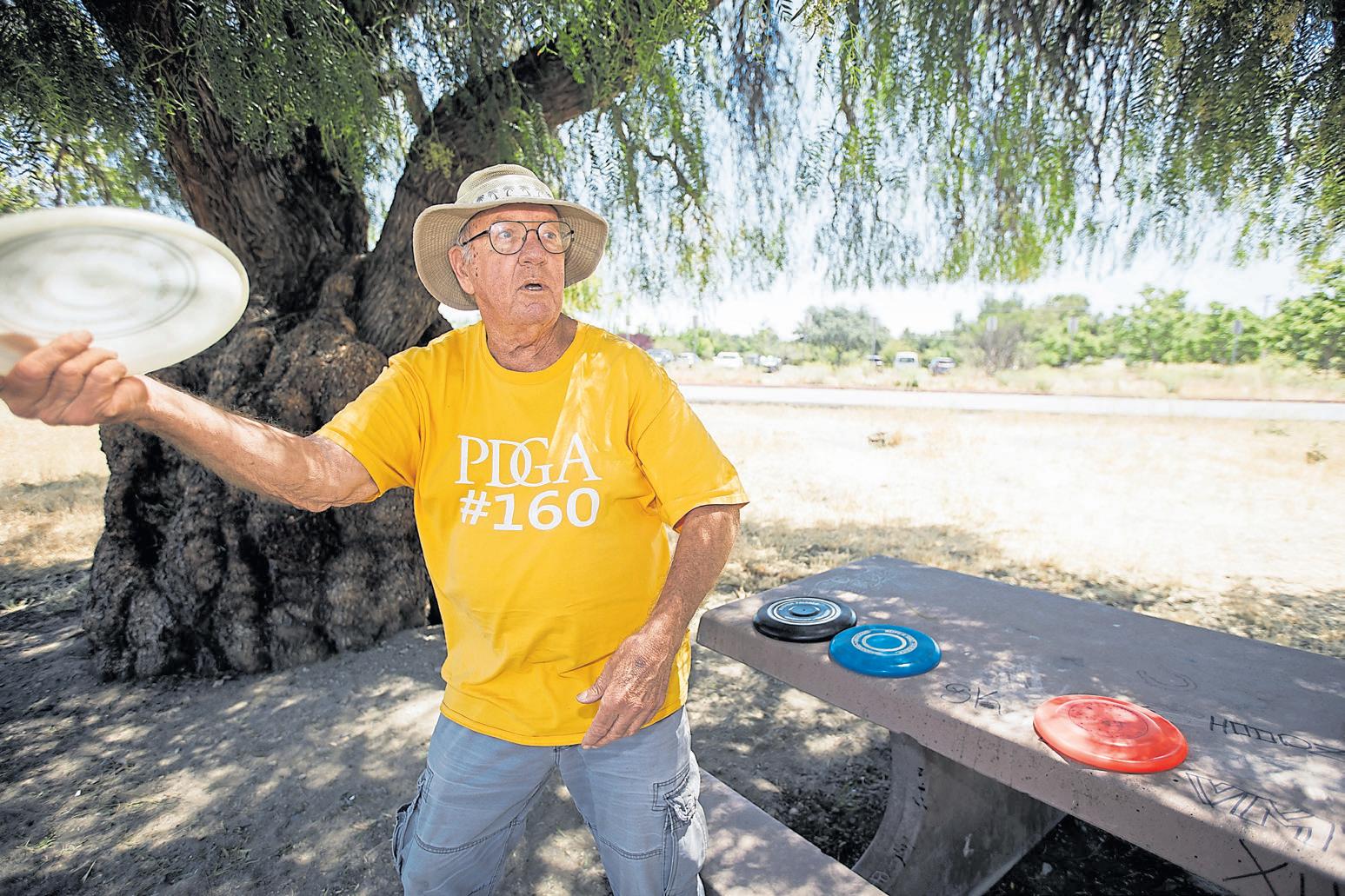

“ We get hundreds and hundreds of people that play out there. It’s a positive thing for the community, at a low cost.”
Jim Challas president of Silicon Valley Disc Golf
trunk, just in case Challas wants to explain why it’s one of the best games in the world to the uninitiated.
“I’m here to spread the gospel of the good name of disc golf,” Challas says with a laugh.
There are more than 9,000 disc golf courses in the U.S, most of which are free for players
to use. California boasts 491 courses, the second-highest number in the nation. In 2021, the state also topped the list for having the most courses added in a year, with 107.
The South Bay has four main disc golf courses: Kelley Park near downtown San Jose, El Parque De La Raza De Paz and Hellyer Park in South San Jose and Villa Maria in Cupertino. Over in the East Bay, disc golfers can enjoy several local courses, including Southgate Park in Hayward, Osterbay in San Leandro and Aquatic Park in Berkeley.
On the same day Challas takes his frisbees to Kelley Park, dozens of players can be seen tossing discs from hole to hole, including his friends Don Savella, Evan Johnson and Craig Rawlings. Slung over their shoulders are specially designed disc golf backpacks that can hold dozens of brightly colored
The trio briefly greet Challas — whom they recognize from attending various disc golf events — then take turns tossing discs towards the basket. They encourage each other and try to take advantage of the warm breeze that helps their discs fly further. When the initial toss is done, they’ll trek to wherever the disc ended up and prepare for their next shot.
“Has anyone seen my red disc?” Savella asks as he disappears behind a shrub. Upon retrieving it, the Burlingame resident then plants himself among the plants, searches for the basket again and takes aim. With the courses spanning dozens of acres, and the baskets separated by various terrains, disc golfers utilize different types of frisbees during the game. There are distance drivers, which help players cover the most ground, and fairway
drivers, which provide more control and accuracy. Midrange discs are also designed for precision for a wide variety of shots. Putt and approach discs, which are smaller in size, are designed for making shorter and more controlled shots.
The average disc golfer can bring around 15 to 20 discs to a game, according to Challas. Some are used for their unique functions, while others are brought as back-ups in case a frisbee or two goes missing in the landscape.
For players like Campbell resident Roderick Kast, disc golf is not just a fun way to stay in shape, but an opportunity to bond with other locals.
The 33-year-old got his first taste of the game during the COVID-19 pandemic. At a time when many regional sport facilities and activities closed down, the disc golf community was able to soldier on and play at several spacious outdoor courses. Kast, a Navy veteran, was experiencing post-traumatic stress disorder and found the game was a good way to get out of the house.
“It was an activity that got me out of a dark room,” Kast said.
Nowadays, Kast can be found tossing discs multiple times a week with his fiancee and their dog at Kelley Park in San Jose or at one of the six disc golf courses scattered across Santa Clara County.
Last year, Kast hosted a local disc golf doubles event to raise money for a charity that helped him during his service. More than 100 people showed up and donated discs and bags for a raffle. They ended up raising more than $1,000.
“The community will come out and support other things than just disc golf,” Kast said. “There’s a lot of camaraderie in it.”
BY JASON MASTRODONATO
Children pedal pastel-colored boats, sailors catch a light breeze and lovers row side-by-side on a suspiciously calm day on the pleasant waters of Shoreline Lake.
Suddenly, a jarring crash interrupts the tranquility.
Two kayakers, once 35 meters apart, completed a full-speed sprint with a head-on collision, a dangerous game of chicken where neither party decided to swerve. The boats connected. Loudly. Nobody was injured. The rowers were prepared for this, with caged helmets and padded life vests.
In fact, they looked forward to this all week.
“I’m about to sell you on this,” one of the rowers,


Matt Summers, told an excited newcomer just before putting his boat into the water. “This is a contact sport. You can push people over.”
This is kayak polo, a sport in which a college freshman and a 60-something-year-old retiree can compete on the same field with equal levels of success.
It’s a sport in which a sixth grader and a sixth-grade teacher can — and quite happily do — drive their kayaks into one another in the name of athletic competition.
It’s a sport that athletes from the Bay Area Kayak Polo Club have dominated on the national stage.
The best in the country train here, at Shoreline Lake in Mountain View, once a week, and few passersby have any idea what’s going on.
“If you see someone kayaking out on the water, and they’re pretty good, we’ll be like, ‘Hey you should come join us,’” Summers said. “People on shore, a lot of the time, they come join. A lot of people ask questions.”
The requirements are quite simple: know how to kayak and know how to roll the boat (get yourself back above water quickly if the boat flips).
Once you’ve got that down, it becomes a game of physical strength and endurance, teamwork and strategy, a sort of hybrid between water polo and soccer, but played in kayaks.
“It looks like basketball,” an observer said on a recent Sunday.
There are five players per team, and the ball can only be moved by passing or shooting. You cannot paddle when in possession of the ball, and you only have five seconds to make a decision. Dribbling requires

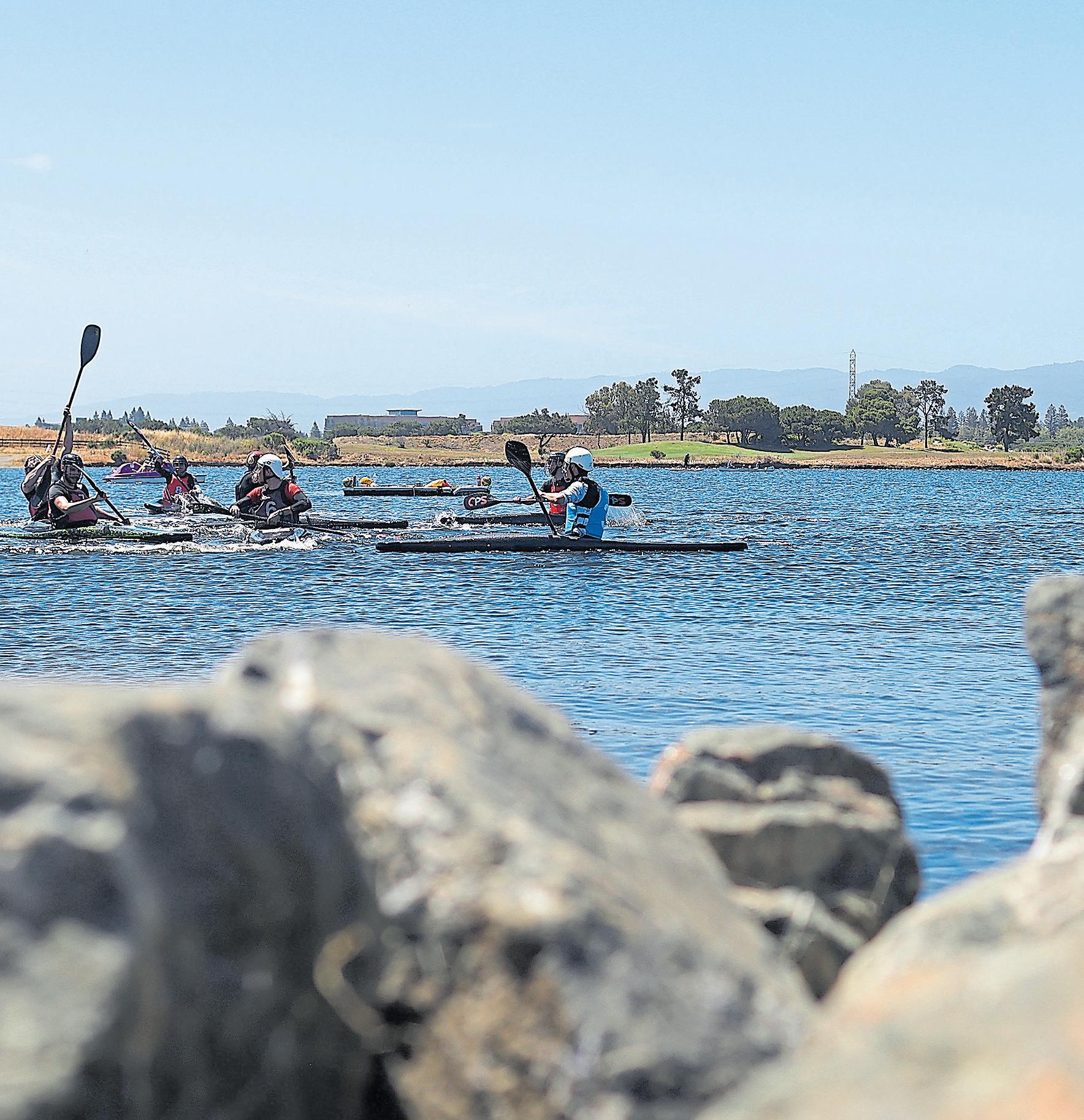
throwing the ball in front of you, then paddling to retrieve it.
Like soccer, there are formations. Different teams use different formations to capitalize on their strengths.
A goalkeeper is positioned under the net, which is 2 meters above the water and stands 1 meter high by 1.5 meters wide (the sport originated in Europe and thus uses the metric system).
From there, a team might play with three defenders and one zonal player roaming along the outside. Or they could play with two defenders and two zonal players. Or a five-player, man-marking system.
On offense, a team might use a pick-and-roll play to generate scoring opportunities from the outside or position one forward player under the net to try to get the ball to them for a closerange shot, not dissimilar to basketball.
Though played on water, the playing area is referred to as a pitch. It is 35 meters long and 23 meters wide, so as soon as one team loses possession, it turns into a frenzy of full-speed kayakers sprinting towards the opposing goal.
“There are a lot of different ways to play,” said Tim Johnson, a team veteran who grew up in the United Kingdom but helped start the Bay Area club in 1997. “Different countries develop different tactics.”
There are maybe 20 people in the entire Bay Area who play regularly, and the best of the bunch travel all over the world — their kayak and oars in tow — to compete against players in other countries.
“We have a number of players who have played on the national team,” said Bay Area Kayak Polo

Kayak polo is a contact sport, and members of the Bay Area Kayak Polo Club wouldn’t have it any other way.
ARIC CRABB/STAFF
Club captain Peter Hargreaves, a middle school teacher in San Leandro. “So our club is one of the higher clubs. We were often winning the U.S. championship or coming in second. A pretty good club.”
On the world stage, though, the United States hasn’t had much success.
Germany has won the last three world championships on the men’s side, and France leads the all-time record with four. On the women’s side, Germany has
the most titles with six.
“Australia used to be very good, and they basically out-muscled the other teams,” Johnson said. “The Dutch team, they were just huge. The British, not really big guys, but they are very athletic. Those big guys don’t do as well now. They’re not fast enough.”
Dylan Kao, a freshman at Santa Clara University, grew up playing the sport in Taiwan.
“Playing in Taiwan, Asian people are smaller, so we use more
strategies and tactics,” he said. “Americans, they play muscle ball. They’re using weight to defend.”
Kao was excited when he found the Bay Area team.
“I really like it because it makes me stand out,” he said.
“It’s a really cool thing to talk about. You really have to be strong mentally, because it’s a hard sport. You have to be determined.”
In the United Kingdom, all the big cities have teams, John-

son said. People often do whitewater slalom in the summer, then in winter switch to polo. But he said slalom is more of an individual sport.
“I’ve seen people come in from various different sports and be good at kayak polo,” he said. “Sometimes you get people who, even if they have no kayaking or ball skills, have the mentality to be able to pick it up if they like the water and the kayak. You just need good physical fitness.”
While the club also hosts practices at Berkeley Marina, Shoreline Lake has been a fitting backdrop for the sport because of its calm waters and warm temperatures that make it particularly refreshing to play in during the summer months.
More importantly, there are so many beginners trying out kayaking for the first time that it can provide a good introduction for folks who take up an interest.
“We had a lot of children and seniors taking kayaking classes
here,” said Christina Ferrari, president of the Shoreline Lake Boathouse.
They teach introductory and advanced kayak classes and rent them out to folks in singles, doubles and enclosed kayaks, the latter of which are used for kayak polo. Interested kayakers can try the polo experience and play a series of rounds on the field.
“We’re on an enclosed body of water, so in summertime, it is salt water from the Bay, and the temperature can get into the 60s,” she said. “There’s plenty of kayaking going on.”
The polo team here has players of all ages, with people from all professions, from all over the world. On a recent Sunday, eight players participating in team practice represented six different countries.
The club also puts on kids programs and will bring gear for them to learn the sport. There’s a kids tournament hosted at Shoreline Lake each spring. A kids team was formed and flown out to New York for a recent national tournament, which they won, Summers said.
“You can basically throw someone in relatively quickly,” he said.
The youngest player who plays with the adults is 11-yearsold and has proven to be quite good.
“The fun part about it being the sport involving so many different skills is you can be good at one of them,” Summers said. “The kids I was working with in the spring, one of them’s like a water polo player so he can really shoot the ball, so he doesn’t have to be a great paddler. We’ll put him in front of the goal, and he can flick it in.” All you need is a paddle and
MORE PLACES TO RENT A KAYAK IN THE BAY AREA
California Canoe & Kayak, 409 Water St., Oakland; calkayak.com/ rentals.
Stacked Adventures, Encinal Boat Ramp, 190 Central Ave., Alameda; stackedadventures.com/rentals.
Sea Trek, 2100 Bridgeway, Sausalito; seatrek.com.
City Kayak, Pier 40, San Francisco; citykayak.com.
Napa Valley Paddle, 6 Cuttings Wharf Road., Napa; napavalleypaddle.com.
Outback Adventures, Del Valle Regional Park, 7000 Del Valle Road., Livermore; outbackadventures.com.
Redwood Water Sports, 487 Seaport Ct., Redwood City; redwoodwatersports.com.
Half Moon Bay Kayak Co., 2 Johnson Pier, Half Moon Bay; hmbkayak.com.
determination, Summers said. A lawyer during the week, Summers will soon compete on the men’s national team in tournaments that can take him all over the world. He’s hopeful kayak polo will become an Olympic sport one day.
“It’s not impossible,” he said.
Details: Kayak classes start at $150, and rentals start at $30 a day. The boathouse is open 10 a.m. until 6:30 p.m., and until 7:30 p.m. on weekends, at 3160 N. Shoreline Blvd. in Mountain View; shorelinelake.com.
BY KATE BRADSHAW
Locals know that our breezes are top-notch and an essential part of a Bay Area summer. Unfortunately, when it comes to summer cocktails, their namesake drink, the Bay Breeze, is ... just okay.
Made with vodka, cranberry juice and pineapple juice, the Bay Breeze is tart, sweet and sippable. It’s one of a trio of cocktails invented in the 1940s as part of a marketing campaign by Ocean Spray and the Cranberry Growers Association to increase cranberry juice sales. (The others were the Sea Breeze, which features grapefruit juice instead of pineapple, and the Ocean Breeze, which features orange juice.)
Closing in on a century later, there’s plenty of room for improvement.
Just ask Kiernan Moran, bar manager at Wunderbar in San Mateo. “To be honest, the original Bay Breeze is a very mid cocktail. Not a lot going on and pretty one-dimensional,” he writes in an email.
So, as we do in the Bay, home to so many inventors and creators, we asked four top cocktail creators to take this concept and make it better. Mixologists at Los Gatos Soda Works, Tallboy,

Wunderbar plus Beer Baron and the Fat Pigeon all took on the challenge — and delivered. Here are their Bay Breeze reboots.
LOS GATOS SODA WORKS
Los Gatos
“At Los Gatos Soda Works, we’ve taken the classic Bay Breeze and given it a bold, imaginative twist,” says owner Nicole Seele. “Traditionally made with vodka, cranberry juice and pineapple juice, our version stays true to its roots while reimagining each ingredient with care
and creativity,” she says. “The result is a cocktail that’s familiar in spirit but entirely original in execution.”
Bay Breeze
1.5 oz Pineapple skin-infused Ketel One Vodka
1 oz Pineapple Cordial
2 oz Spiced Cranberry Soda
Pineapple Skin-Infused Vodka
16 oz Pineapple skins
1 Liter Ketel One Vodka Infuse for 24 hours. Strain and bottle.
16 oz Ocean Spray Cranberry Juice
Cocktail
16 oz white sugar
6 dashes Angostura bitters
Heat and stir until sugar dissolves
Spiced Cranberry Soda
2 oz Spiced Cranberry Syrup
6 oz water
Carbonate
Pineapple Cordial
16 oz fresh pineapple juice
8 oz sugar
2 oz citric acid
1oz Ketel One Citroen Vodka
Oakland
At Tallboy, Oakland’s thriving new ’tinis-and-weenies dive joint, owner Den Stephens shared his spin on the Bay Breeze, which he calls Trade Winds. It features aperol and lime juice alongside cranberry liqueur and fresh pineapple, vodka and simple syrup.
Trade Winds
1.5 oz vodka
.25 oz Aperol
.25 oz Clear Creek Cranberry Liqueur
1.5 oz fresh pineapple
.5 oz fresh lime juice
.25 oz 1:1 simple syrup
Build all ingredients in a Collins or pearl diver glass. Swizzle. Garnish with fresh mint sprigs and a tall straw.
San Mateo
Kiernan Moran’s riff on the Bay Breeze, called “I’m the Problem,” starts with Lo-Fi Gentian Amaro. “This particular amaro has great red berry and herbal complexity that mimics the cranberry juice used in the original cocktail but offers a little more complexity with the herbs and spices used,” he says. It uses pineapple and guajillo-chile-infused vodka. Why?
“Well, pineapple and chile go hand in hand! Have you ever had Tajin sprinkled on pineapple?! Muah! Chef’s kiss!” he writes. “The chile is there to add warmth to the cocktail but not spice. I do not intend for this cocktail to be spicy.”
I’m the Problem
1½ oz pineapple and guajillo-chileinfused vodka
½ oz Leopoldo’s Sour Lime Cordial
½ oz Lo-Fi Gentian Amaro
¾ oz lime juice
¾ oz simple syrup
To make the pineapple/ guajillo chile vodka:
One 750ml bottle of your favorite vodka 1 ripe pineapple (skinned, cubed and cored)
4-6 (depending on flavor you prefer) dried guajillo chiles
Rip the ends of the guajillo stems off the chile and split down the seam of the chile, remove all seeds. Repeat for all chiles being used. In a sous vide safe bag, place the pineapple, chile and vodka into the bag and then carefully drop into a sous vide bath set at 145 degrees. Let contents steep for 1 hour. Remove bag from the bath and, using a chinois or cheese cloth, pour contents of the bag through to strain out solid ingredients. Because of the alcoholic nature of the contents, these should last at shelf temperature indefinitely.
For the drink: Combine all ingredients into a Boston shaker. Add ice and shake ingredients vigorously for 8 seconds. Double strain contents into a Collins glass over a long spear cube.
Garnish: Dust the outside of the glass with tajín or a chili lime salt. Place a lime wheel deep inside the glass.
Oakland, Livermore, Santa Rosa and Pleasanton
Harpreet Judge, owner at Beer Baron and Fat Pigeon, crafted a different spin on the drink. He uses grilled pineapple juice, citrus vodka and white cranberry-peach juice for a balance of flavors, then clarifies it in milk tea and adds sea salt foam to the top.
Bay Breeze
1 oz grilled pineapple juice (see prep below)
2 oz white cranberry & peach juice
2 oz St. George California Citrus Vodka
¼ oz simple syrup
½ oz fresh lime, juiced

Beer Baron and Fat Pigeon owner Harpreet Judge crafted a version of the Bay Breeze made with grilled pineapple juice, cranberry and peach juice, citrus vodka and a clarified milk wash — all topped with sea salt foam.
COURTESY HARPREET JUDGE

The Trade Winds cocktail, a riff on the Bay Breeze, by Den Stephens, owner at Tallboy, is made with vodka, Aperol, cranberry liqueur, pineapple and lime juice.
COURTESY DEN STEPHENS
Milk Tea
1.5 g Russian River “Italian Holiday” tea
1 cup whole milk
Heat milk over medium-low heat until it reaches 125 degrees. Add tea and let steep for 10 minutes while keeping milk at a gentle simmer. Turn off heat, remove tea bag and set milk aside.
Sea Salt Foam
1.5 g soy lecithin powder
200 ml water ¼ tsp sea salt
Combine all ingredients in a wide container. Lower a hand frother just below the surface. Froth until a stable foam forms on top. Set aside.
Grilled Pineapple Juice
Cut fresh pineapple into ½-inch rounds. Grill over medium-high heat for 5–6 minutes per side. Juice the grilled pineapple and strain for a smooth texture.
Combine grilled pineapple juice, white cranberry & peach juice, vodka, simple syrup and lime juice in a container. Chill thoroughly.
Prepare milk tea and keep warm (around 125 degrees.)
Slowly pour the chilled cocktail mixture into 1.5 oz of the warm milk tea.
Let sit undisturbed for one hour to allow curdling.
Strain the mixture through a coffee filter for a crystal-clear result.
Prepare sea salt foam.
To Serve
Place an artisan ice cube in a double rocks glass.
Pour the clarified cocktail over the cube. Spoon sea salt foam on top.
Garnish with a dusting of dehydrated pineapple and black lime powder and two fresh pineapple fronds.
Pro Tip: Clarification requires patience. Don’t rush the straining process.

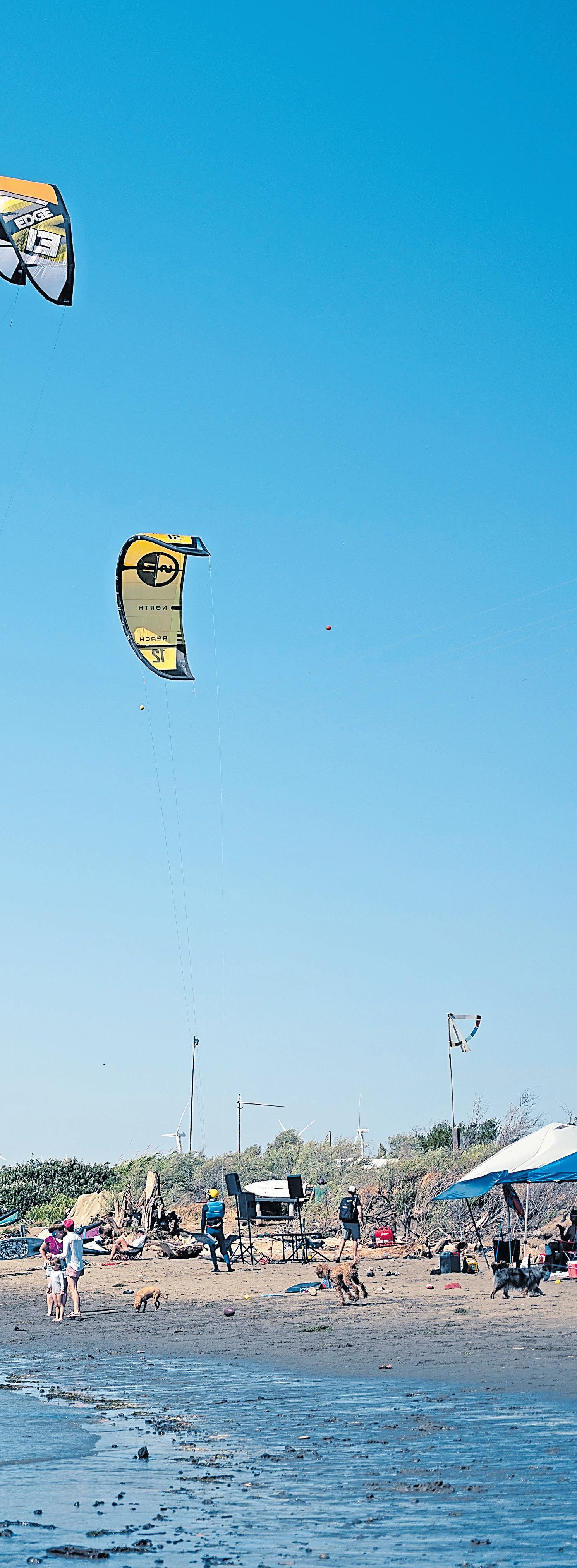
STORY BY MARTHA ROSS
PHOTOS BY DON FERIA
On the final Saturday in May, the midday temperature in the historic Delta town of Isleton climbed oppressively close to 100 degrees during what turned out to be a mini, late-spring heat wave in Northern California.
Locals hoped that the legendary Delta Breeze would begin blowing in off the nearby Sacramento River to cool things down. A drop in the temperature would enhance a longplanned celebration: the grand opening of a new Main Street park dedicated to their town’s Asian American history.
“On days like this, you’re praying for the breeze,” said Judy Vandeventer, a 26-year Isleton resident. Her home on a levee road outside town overlooks the San Joaquin River, and the breeze — nature’s air conditioner — lets her throw open her windows and doors on summer evenings.
Delta residents love to share their experiences with this summertime weather phenomenon, in all its complexities, and how it affects their daily activities and even their life choices. “The Delta Breeze is a real thing,” says Iva Walton, Isleton’s mayor.
The breeze originates in the Pacific Ocean, more than 50 miles away, and meteorologists and atmospheric scientists say it can bring a few degrees of relief on hot days to the millions of people who live, work and play in the Delta, a region that extends from Vallejo to Sacramento and Stockton.
Alas, the Delta Breeze didn’t reach Isleton in time for the May 31st
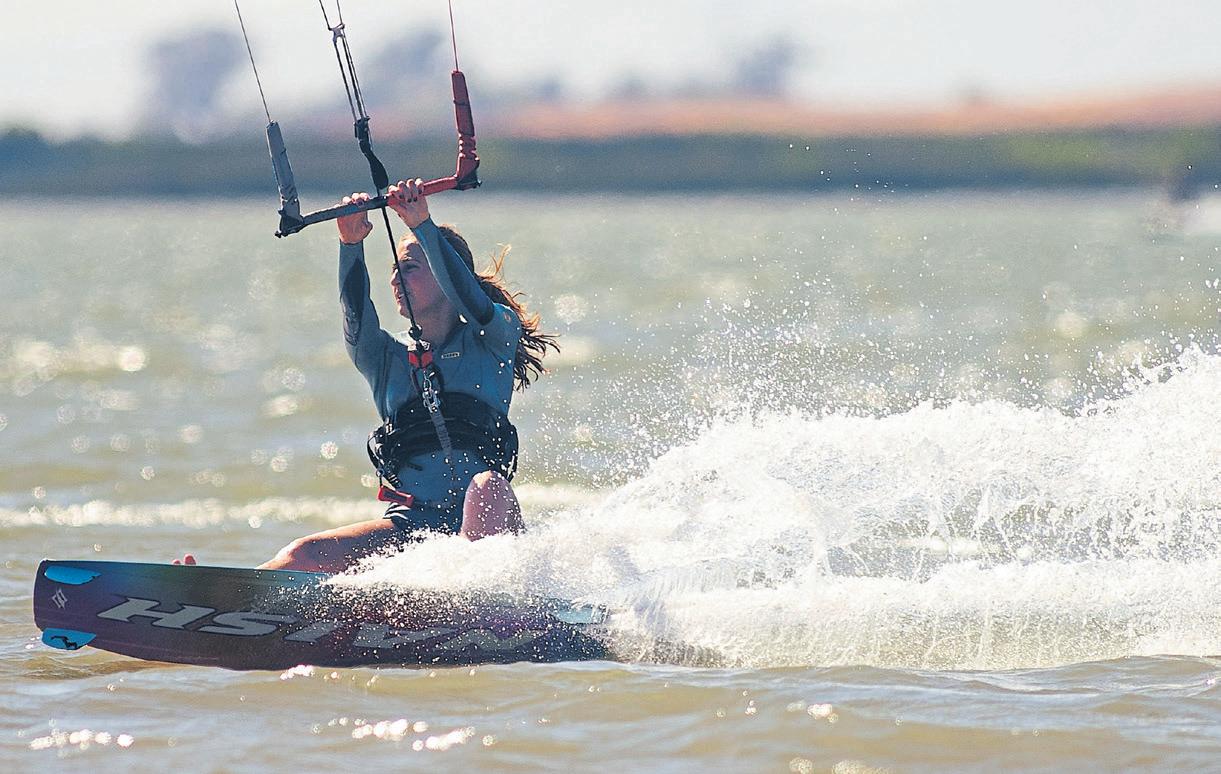
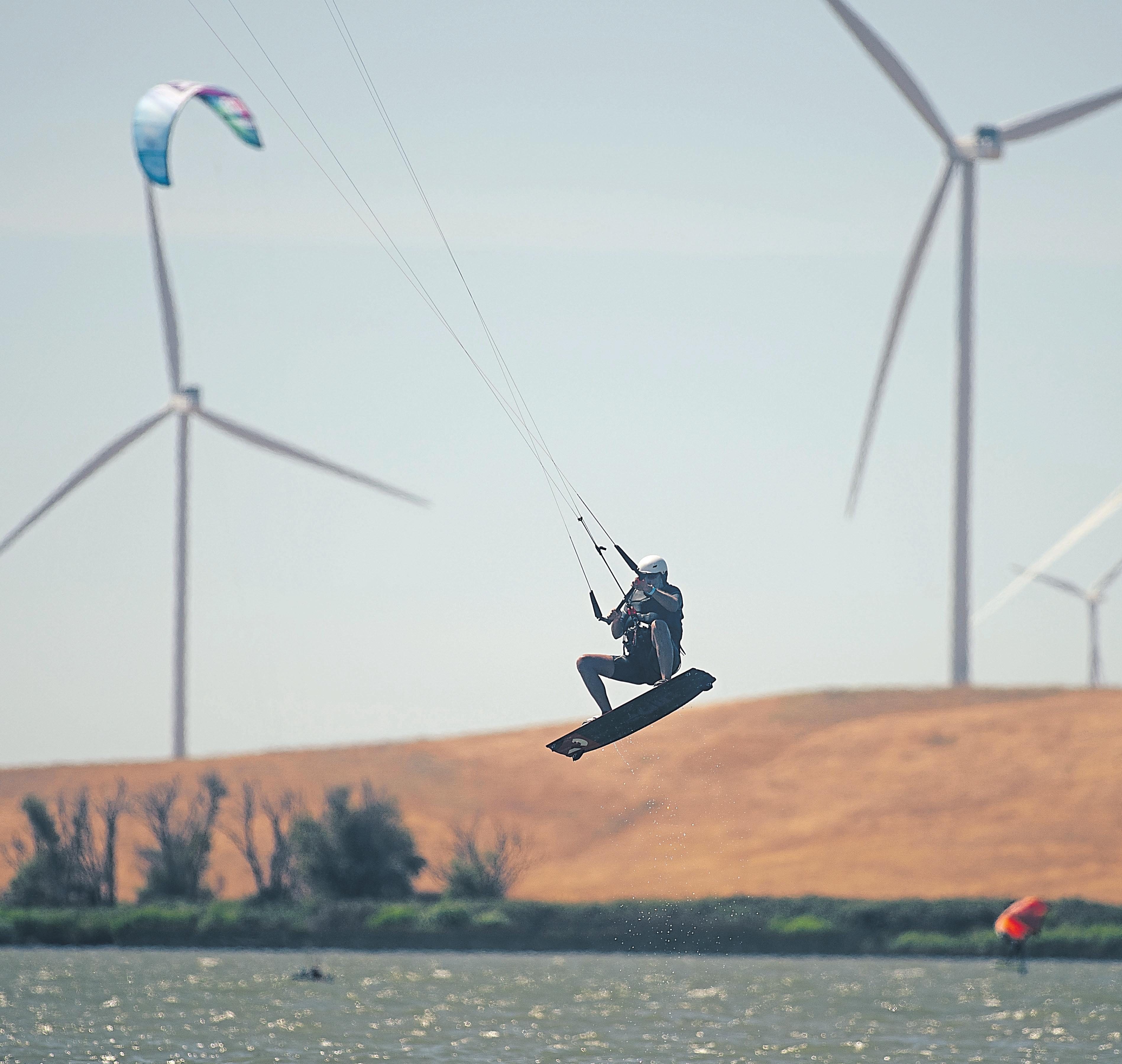


event, and people made do, enjoying the Taiko drummers and other entertainers with hand fans under the shade of a large tent. But the wind was blowing pretty hard several hours later and about 12 miles to the southwest on Sherman Island.
On the western tip of this low-lying island, near the confluence of the Sacramento and San Joaquin rivers, a dark sandy beach faces directly into the headwinds, which makes it a popular destination for kiteboarding, windsurfing, wing foiling and other water sports that depend on wind power. On the last day of May, it was also about 10 degrees cooler on the beach than it was in Isleton.
“It’s phenomenal here. It’s, like, why we don’t leave here in the summer,” said Emily Haw, a kiter from San Francisco, who was participating in an annual event to mark the start of the summer wind sports season in the Delta. Haw, who learned to kiteboard in Maui four years ago, has “chased the wind” to Brazil; New Zealand; Portugal and Cape Town, South Africa.
Above and opposite: On the western tip of Sherman Island, the beach faces directly into the headwinds, which makes it a popular destination for kiteboarding, windsurfing and wing foiling.
But Sherman Island has “the best wind, honestly,” she said.
This “phenomenal” wind starts in the late spring and is the result of cool, moist air currents from the ocean, according to Ian Faloona, an atmospheric scientist at UC Davis. As inland temperatures rise, the currents push in through two major openings in the coastal range: the Golden Gate and the Petaluma Gap, lowlands that run between Bodega and Tomales bays and Petaluma. From San Francisco and San Pablo bays, the cool air travels up through the Carquinez Strait, usually arriving in the Delta in the late afternoon.
“The micro-meteorology around the Bay Area is really complex, but generally speaking, you have the flow coming in off the ocean into that Carquinez opening and then filling the Sacramento Valley to the north and the San Joaquin Valley to the south,” Faloona said. The breeze often reaches Sacramento or Lodi and can extend as far north as Redding or south as Bakersfield. However, by the time it reaches these towns at either end of the valleys, it gets blocked by the surrounding mountains, where it tends to stagnate and heat up so that it “no longer feels cool and breezy,” Faloona said.
Delta residents like to dish about micro-climates related to the breeze. It might be blowing at Vandeventer’s home, on the south side of Brannan Island, but not at her friend’s house 3 miles north, along the Georgiana Slough. Meanwhile, Sherman Island, closer to the Carquinez Strait, is likely to be
breezy even when there’s not much wind upriver, as was the case in Isleton on May 31. “It’s always blowing” on Sherman Island, said Judy Vandeventer’s husband, Skip.
When the kiters gathered on Sherman Island for their event, wind speeds had reached 15 to 24 mph by about 4:30 p.m., enough for Haw and other serious kiters to participate in an “expression session,” a demonstration of their highest-flying, wind-aided, over-water stunts.
Several people at a time headed into the waves lapping onto the beach and let the wind catch their kites and pull them out on their boards. They raced across the surface of the water to gain speed and lift. Once in the air, they performed twists, flips and front and back rolls.
“It’s special here,” said Michaela Pilkenton, a professional Big Air kiter who traveled from Hood River, Oregon, for the Sherman Island event. “This is a light day. We usually prefer it a bit windier, but that’s why the Delta is really nice. The wind is usually like 18 knots (20 mph) and pretty consistent.”
This consistency explains the presence of massive wind turbines, visible from Sherman Island, that now dominate the landscape of the low-rise Montezuma Hills, directly across the Sacramento River. Some 1,000 turbines, operated by several wind farms, have been credited with providing clean energy, creating jobs and benefiting the local economy.
But kiters say the massive, rotating turbine blades have slowed the flow and created pockets of turbulence further up the Sacramento River, near Rio Vista, where they used to gather before gravitating to Sherman Island.
As always, kiters “chase the wind.” That’s the case for Terri Henderson, president of the Rio

Vista Windsports Association and one of the organizers of the opening day event. Henderson began wind surfing on the Delta in the 1980s but has since switched to kiteboarding, which she said is easier on the body.
A former Delta Dental employee who raised her two children in the East Bay suburbs, she and her husband have built their retirement around being near the best wind possible for kiteboarding. They live on the coast of Baja, California, during the winter, then return to their island home near Isleton in the summer. She likes to get out on the water as much as possible.
“When it’s 100 degrees in the valley and there’s fog on the coast, that’s the perfect mixture to get wind coming off the water,” Henderson said. While the breeze generally picks up in the afternoon, Henderson said, “There’s some days when it’s blowing in the morning and
Above:
Beachgoers experience the Delta Breeze at Sherman Island.
Opposite: A disc misses the basket at Kelley Park Disc Golf Course in San Jose.
DAI SUGANO/STAFF
times when it’s blowing all day. It’s kind of amazing. We’re all just on hold, waiting for the wind.”
The dynamic mix of cool ocean air and hot inland temperatures affects the intensity and timing of the Delta Breeze, according to Dakari Anderson, a meteorologist with the National Weather Service. “You need the valley to be hot enough where it actually creates the effect,” he said.
It’s the pressure differences between hot inland temperatures and cool coastal temperatures that bring the wind up through the Carquinez Strait, Faloona added. “So you’ll often get the peak temperature difference around 4 o’clock, but you might get even stronger winds a couple hours later, and then gradually, that will decrease and weaken that pressure gradient force which is pushing that air on shore,” Faloona said. “And in the middle of the night, it’s
generally when the winds are weaker, because that temperature difference has shrunk.”
Much of the talk about the Delta Breeze these days also focuses on how it might be affected by climate change. Faloona said the increasing frequency of 100-plus-degree days inland could mean that the Delta Breeze will grow stronger.
Meanwhile, Delta residents will continue enjoying this weather phenomenon when they can. When the wind starts blowing up from the Carquinez Strait, “it just kind of rolls right over the levee and down Main Street,” said Walton, who also owns the popular Mei Wah Beer Room in Isleton.
The breeze is especially welcome on Sundays, when the beer room hosts live music outside on its patio. Walton said: “The other day it was in the mid-80s, but with that breeze, it was just like, ‘What a perfect day.’”
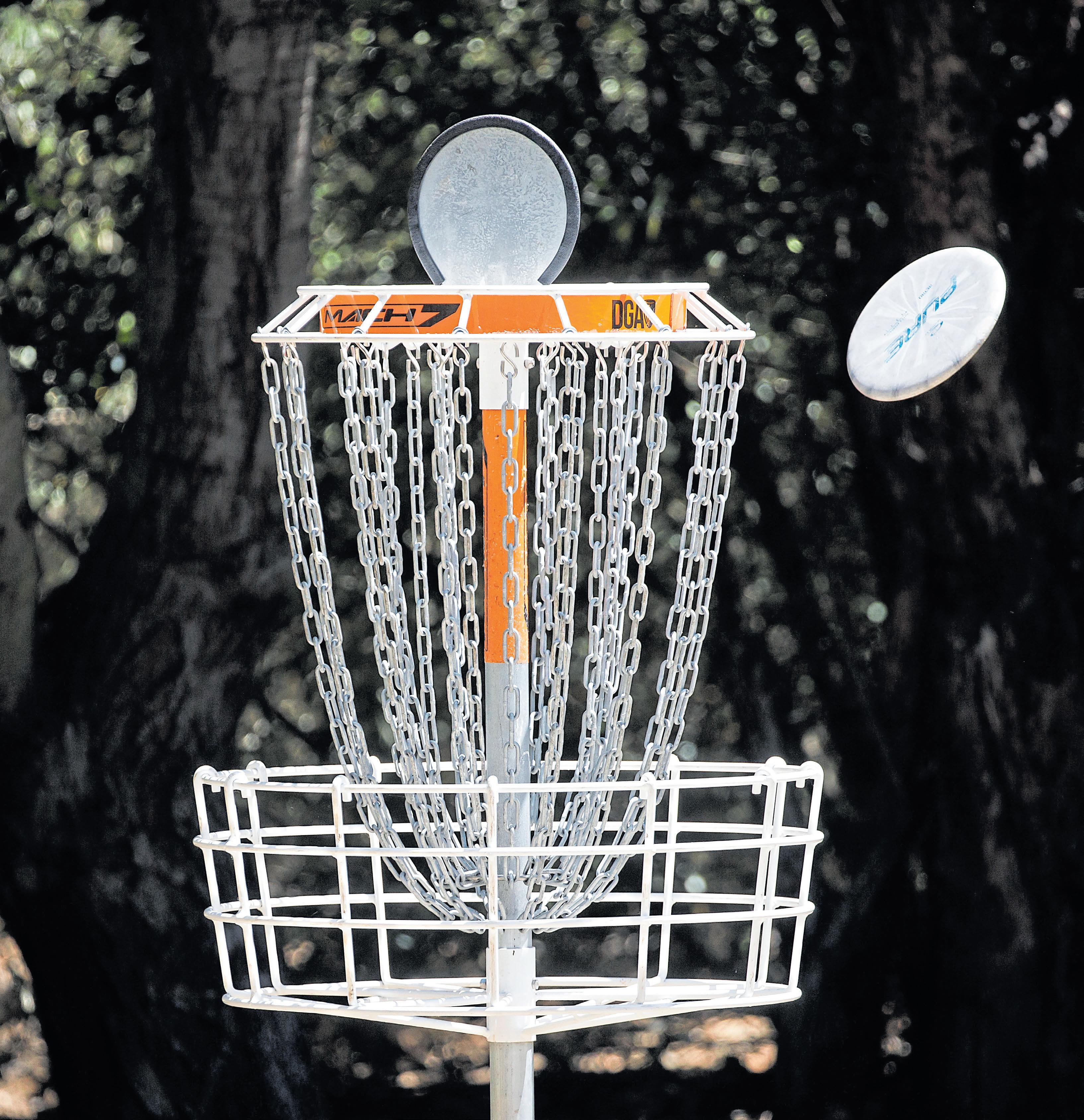

Buzzy new restaurant openings, taproom updates and delicious recipe inspiration fill this free weekday newsletter. apps.mercurynews.com/newsletters/eat-drink
inspiration for West Coast road trips, weekend getaways and close-to-home fun every Monday morning. apps.mercurynews.com/newsletters/travel-play